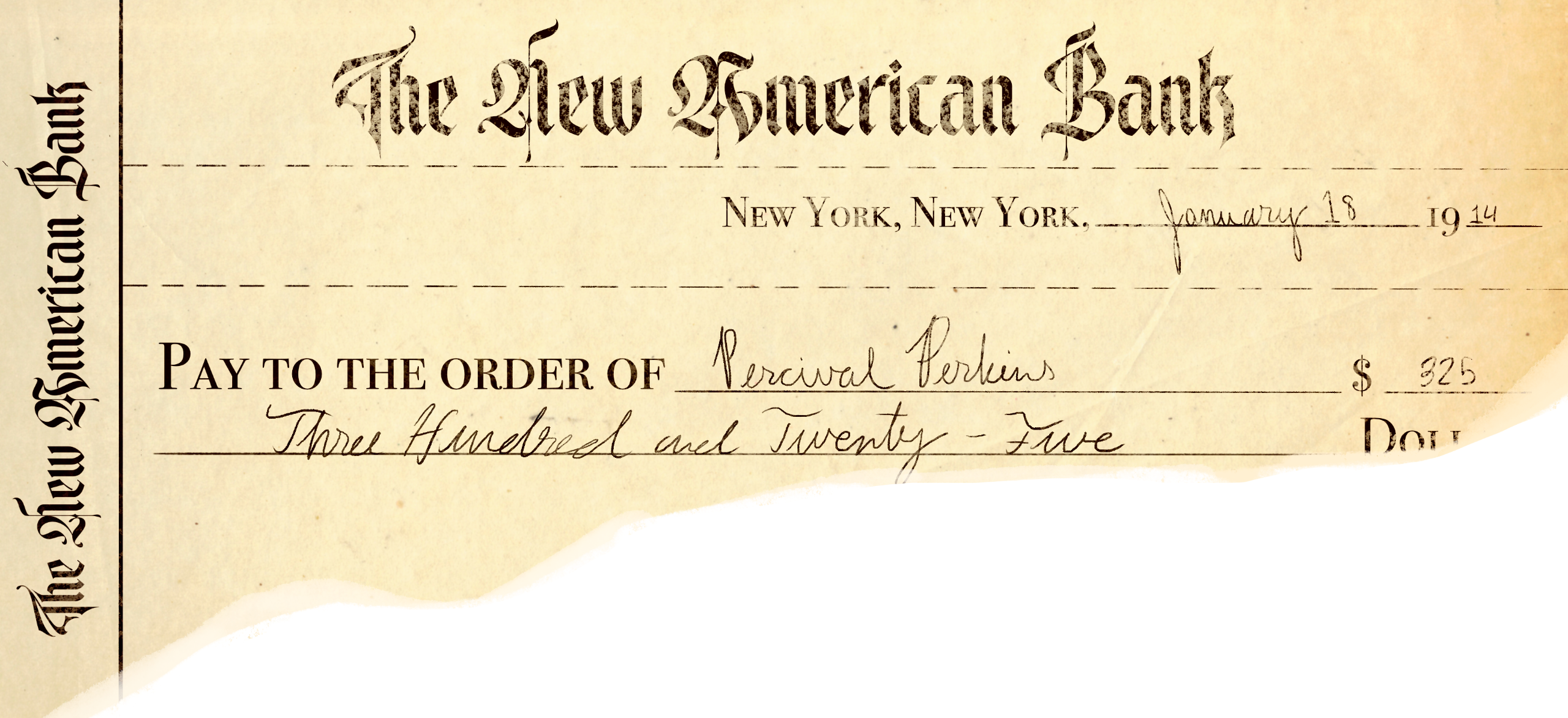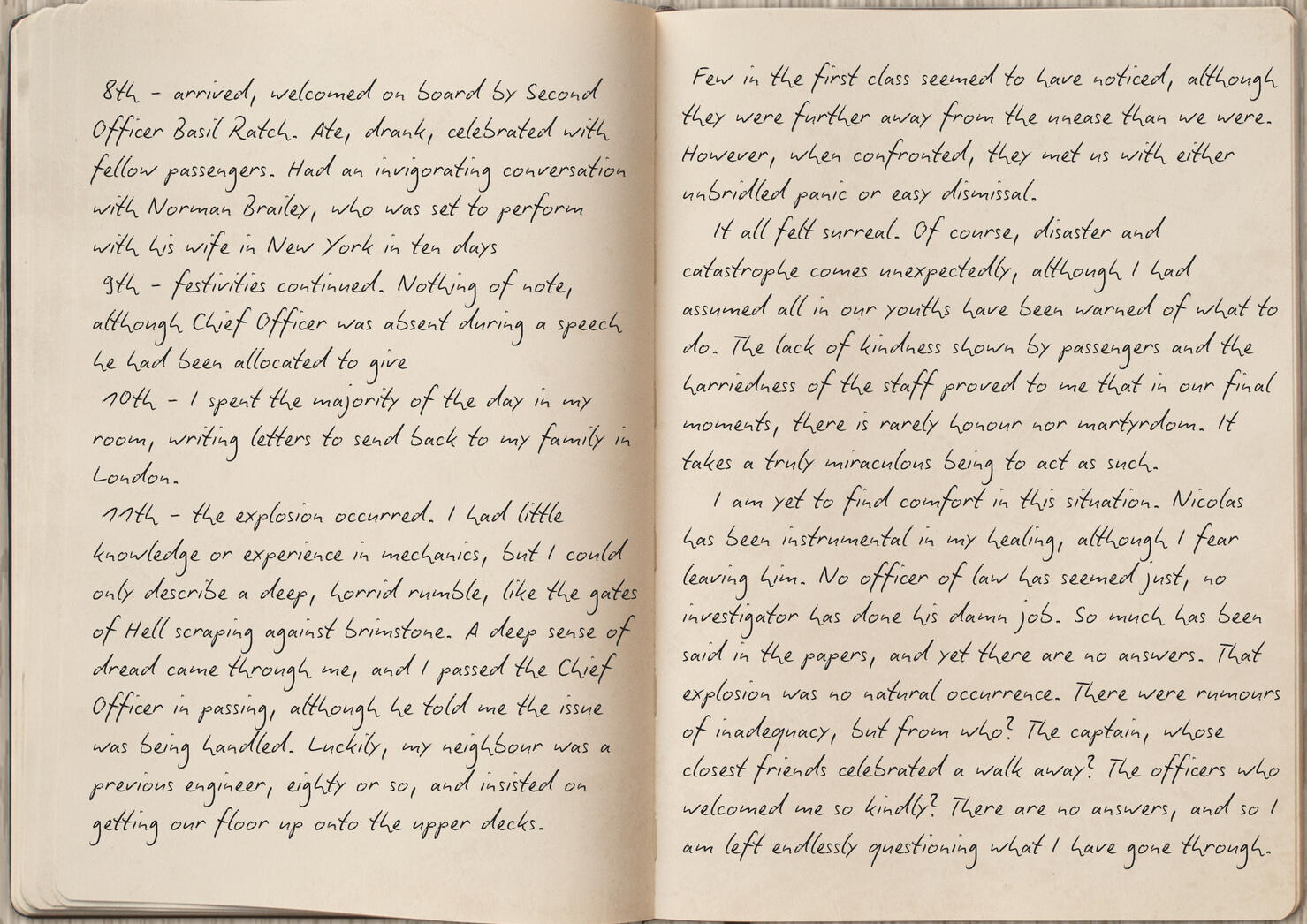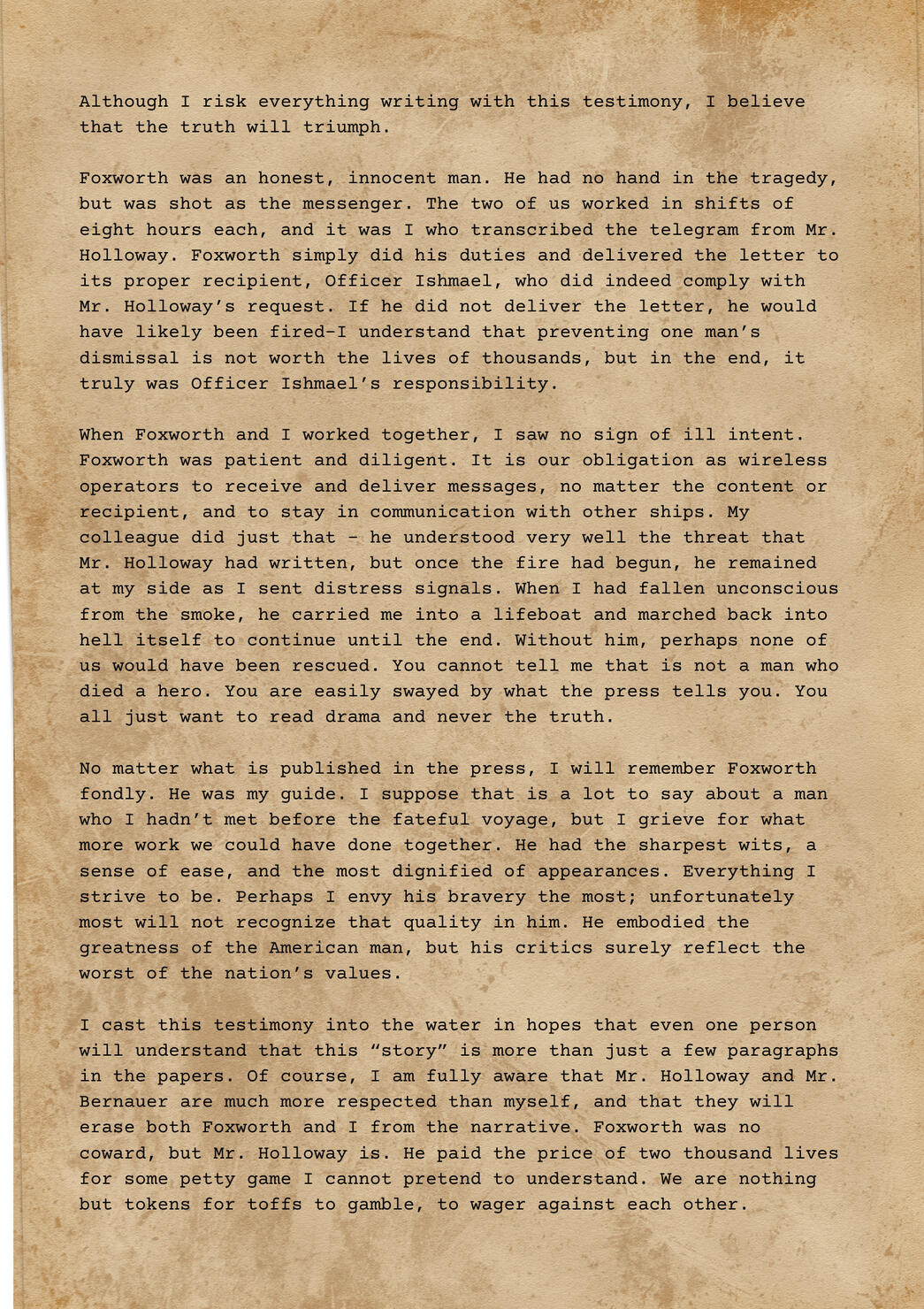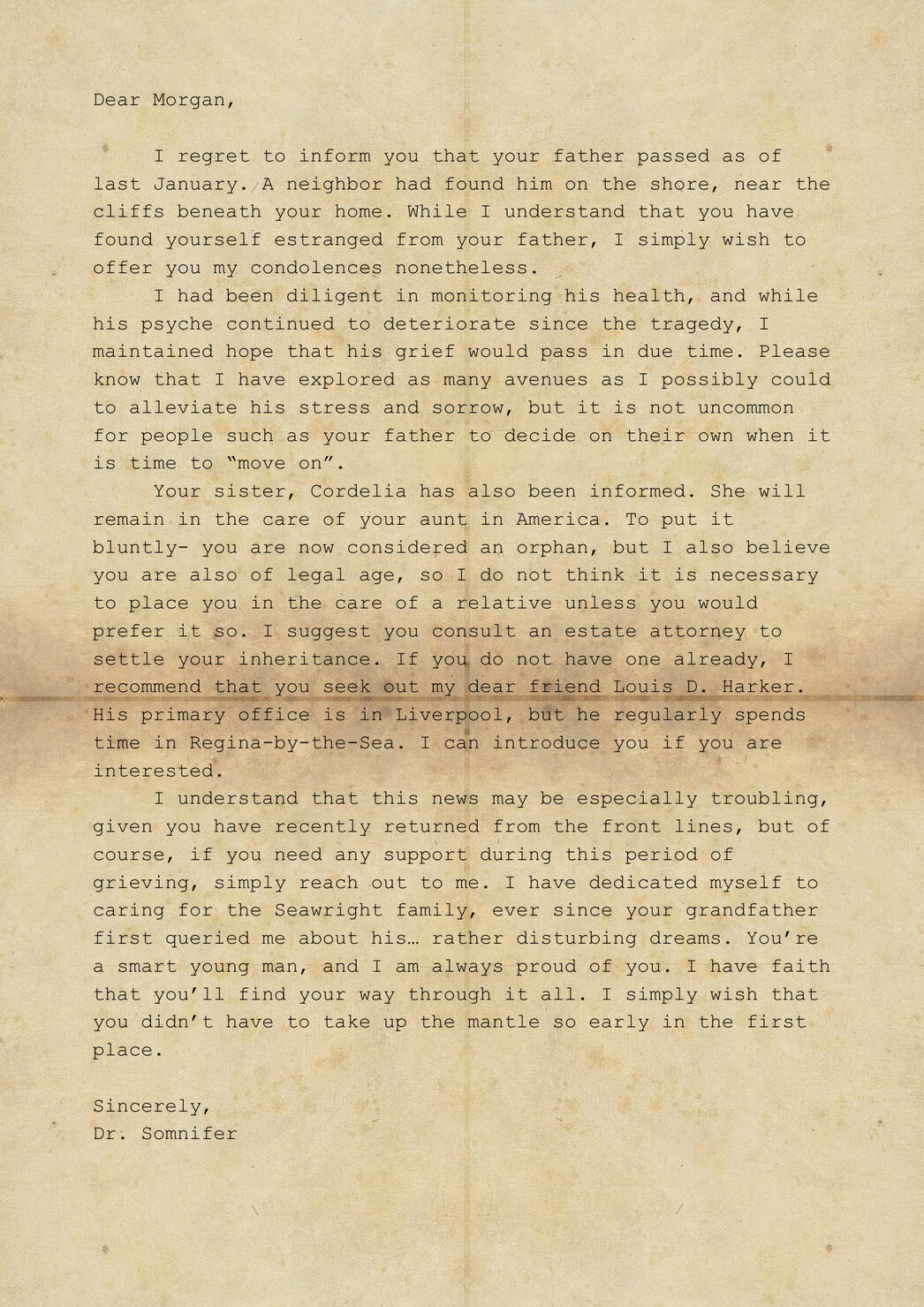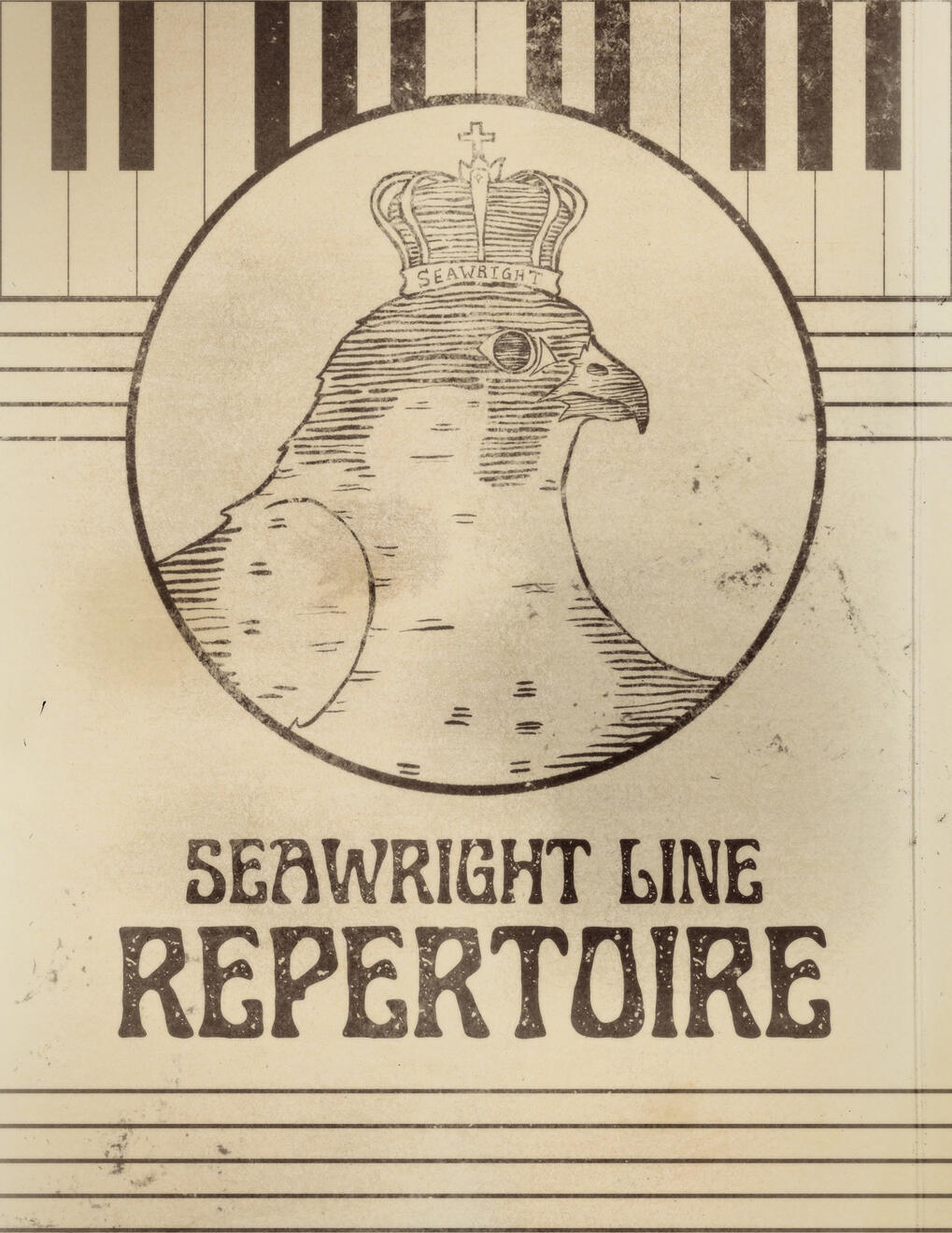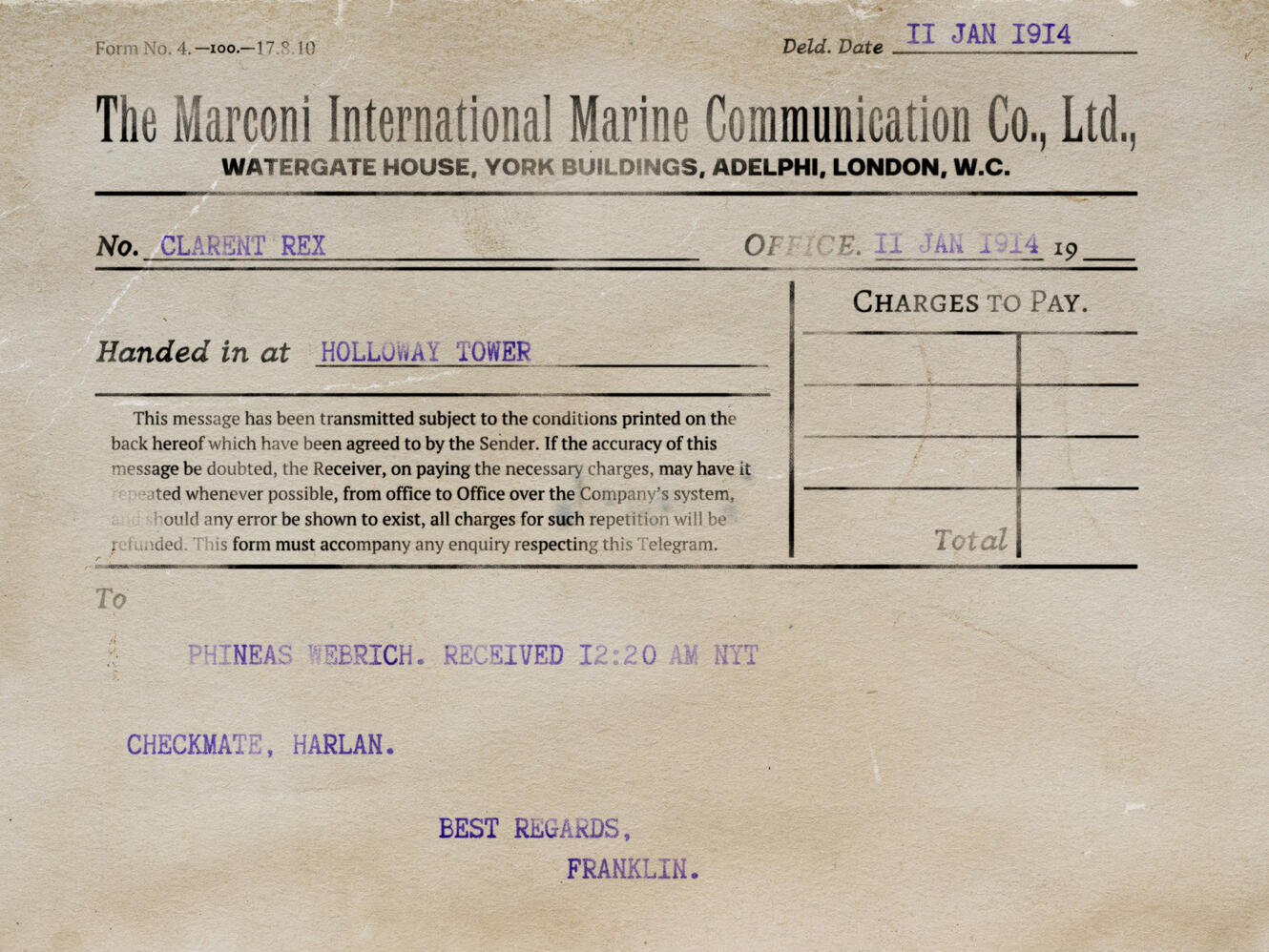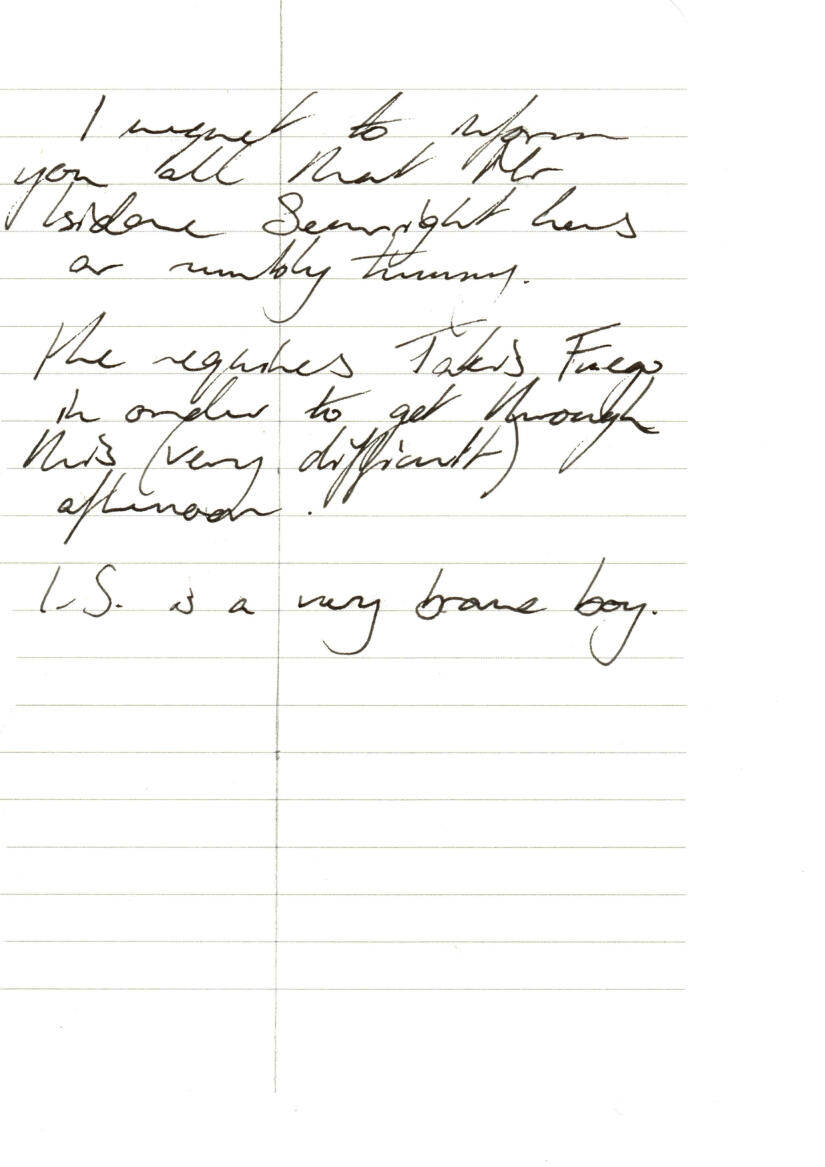January 11, 1934
Mr. Winston Willbond
41512 Woodstyn Ave.
St. Imber, USA
This website was created by the Seawright Historical Society. All documents have been generously provided by the foundation and its donors. Best experienced on desktop.
Photograph and note authored by Winston Willbond. January 11, 1934.
Telegraph sent from Martha to Winston. January 22, 1934.
WARNING! YOU ARE ABOUT TO ENTER PREVIOUSLY CLASSIFIED ARCHIVES. CONTENTS MAY BE DISTURBING FOR SOME VIEWERS.
DEAR CLARENT - A SEAWRIGHT HISTORICAL SOCIETY ARCHIVE
OUR MISSION
The same story can be told in a multitude of ways. Likewise, history is a narrative that's constantly rewritten.The Seawright Historical Society (SHS) is a dedicated circle of historians and associates based at Westcote University and other leading research institutions. After the Seawright Line disappeared in the 1920s, most information about its fleets and the individuals involved in the company were lost. Alongside the company's liquidation, much of its documents and history were either destroyed or hidden.With a number of competitors and allies alike, remaining media reveals conflicting views on the endeavors of the Seawright Line, the Seawright family, and those involved in the disaster- particularly in Westcote University's home base of St. Imber. Our aim is to obtain a wide variety of resources in order to provide a critical, unbiased view of history to preserve the legacy of this once great, yet enigmatic shipping empire.
Due to the previously classified nature of the content that the SHS publishes, many contributors have decided to remain anonymous. Credits will be given when applicable.
With that being said, the current chairman of the foundation, Charles Vinfrank, has agreed to be the public face of the SHS. All communications will be managed by Mr. Vinfrank and his team of teaching assistants on behalf of the foundation.The Seawright Historical Society is available for communications through our email and social media.
Special thanks to the Westcote University computer science department for creating interactive modules on this site.
4
THE S.S. CLARENT REX
Artistic rendering by Alex TJ

Length: 885 ft 8 in
Beam: 93 ft
Height: 176 ft
Draft: 35 ft 2 in
Decks: 9
Propulsion: Triple-Screw
Service: 22.5 knots (26 mph)
Max: 24 knots (27.6 mph)
Clarent Rex was built in Regina-by-the-Sea by Farnaby Ironworks & Shipbuilding as the first of two ships in the “Seawright Stars” duo- the second being “Excalibur Polaris.” Following Seawright Line tradition, the sister ships’ names were derived from mythology- Arthurian legend in this case. Upon her completion, Clarent Rex was the largest ocean liner in the world, beating the record set by Cunard’s Mauretania.The sister ships were first conceptualized in 1905 during a lunch discussion between the line’s chairman, Isidore Seawright, and Franklin-Westcote Holloway, a long-time patron and investor. Historians speculate that Holloway suggested the development of these liners to compensate for growing competition in the mining industry, with the Canary Crest Group controlling a majority of global metal and gemstone distribution. The Westcote Mines Company was experiencing a steep decline in income which would have been remedied by supplying Farnaby Ironworks & Shipbuilding with the steel needed to build the Seawright Stars. Unfortunately, Alva Snowshire of the Canary Crest Group soon offered to supply steel at a lower cost, a deal which both Seawright and Farnaby accepted. Despite taking offense, Franklin Westcote-Holloway agreed to continue funding construction, believing that dividends derived from the increasing popularity of the Seawright Line would bring a positive return on investment.Construction of Clarent Rex began in December of 1905. While progress was on time, it was not without an alarming number of incidents occurring along the way. A notable count of twenty-three workers died during construction- much more than any other project at the time. More workers reported rapid illnesses and suffered from injuries. No particular cause of these troubles has been found. The final victim of the rumored “Curse of the Clarent” is said to have been the Seawright family patriarch, Noah Seawright, in 1908. While he passed peacefully at home, the disappearance of his body strangely coincided with a halt in the string of construction employee fatalities.Clarent Rex was launched on May 15, 1908. Her maiden voyage began on June 20, 1909. Isidore Seawright was accompanied on board by his wife, close friend and composer Norman Brailey, and naval architect Rowan Gregg. Captain Marvyn Seawright, brother of Isidore, was given command of the ship. He would return to this position again in 1914 during her final infamous voyage.Clarent Rex had a number of facilities for guests to enjoy, including an extensive library and a small domed greenhouse near her stern. These eccentric luxuries made the Seawright Stars- and thus the Seawright Line in general a much more intimidating competitor to the White Star Line, who was also known for their luxurious liners. Even the third class cabins were meticulously designed for both function and aesthetics.Another unique aspect of Clarent Rex was her involvement in the world of exploration and artifact curation. The Seawright Line would schedule “expeditions” every few years with various ships, in which they would travel outside of their usual, western-oriented course. The company would sponsor scholars, reporters, and explorers to visit classically-historic locations, notably Egypt, to promote the cataloging and transport of artifacts and other findings from these places. It is important to note, that while the individuals involved with these expeditions believed that their efforts were needed and justified, these trips contributed to British and American imperialism during this time period. Many artifacts and goods were not logged, or were noted under code names in order to conceal blatant theft from their home nations. Nonetheless, Clarent Rex could be considered an example of both a standard ocean liner and one of the earliest cruise ships. Her versatility made her popular with members of both American and British high society.In late 1913, Alva Snowshire bought the Seawright Line in a successful attempt to outcompete the recently deceased J.P. Morgan in monopolizing the shipping industry. Like the International Mercantile Marine, Snowshire’s Canary Crest Group owned multiple shipping lines, such as the Grand American Line, Lovett Maritime, and the Eldred Line. The Seawright Line was the only British company under her control. Webrich Industries subsequently bought significant shares of the Canary Crest Group following the formation of a business alliance between Alva Snowshire and Phineas Webrich. Strangely, records have revealed that Westcote-Holloway ceased his investments in the Seawright Line shortly after this change of ownership.The sinking of the S.S. Clarent Rex resulted in great financial loss for Snowshire, who quickly sold the company to the Seawright Line’s long time rival, the Northeast Atlantic Line.This disaster is considered to be the catalyst for the downfall of the Seawright Line. While Clarent Rex has been the “answer” to many turn-of-the-century events, no event has yet proven to be the answer to the mystery of the Clarent.
ABOUT "DEAR CLARENT"
In the winter of 1934, two amateur sleuths, Winston Willbond and Martha Howick, embarked together to investigate the peculiar sinking of an ocean liner: the S.S. Clarent Rex of the Seawright Shipping Line. At the time, the story was known as a disaster caused by a faulty boiler explosion; however, the pair speculated that the tragedy may have been more than an accident.Like the Seawright Shipping Line, the duo's case strangely vanished alongside any trace of the company it pertained to. A supposed conclusion was reached, but documentation relating to the investigation was dispersed prior to the Second World War due to B̸̛̝̰̮̰̞͇̠͖̝̠̲͎̼͉̮͙͎̤̞̪͎̥̺̘͍̤̔̒̉͋̂̿͑͛̏̂̉͌̕̕͘͘͝͝͝ͅͅͅR̸̨̧̡̩̠͔͚͕̺̙͈̘̫̼̭̦̲̘͙̞̜̤̭̘̰̒̑̂͛͗͋̂̊͋́̉̏̊͊̽͐̈́̏͒͐̏̚̕͝͝E̴̤̭̋͐́́̌A̶̰͚̟̝͑̈́̊̊̏̍̎̃̿̓̂̐͌͘̕͠͝H̸̢̧͈͎͍̱̜̠̥͔͇̭̪̭͍͙̟̼͂͆̉̋̑̌͗̈́͊̚̚T̷̯̟̻̙̫̬̙̟̼̭̉̇͋̓̏̍̔̃̃͑̓̆͌̊͆͘̚͜͠Ȩ̶̛̛̛̛̻̙̳̤̺͍̹̻̥̓̉̐͒̀̈́̒̅̊̄͆͂̇̉̆̀̐̆͗̿͑̌͂͐̐͆̓̓̿́̚͘͘͝͠͠͝The Seawright Historical Society began organizing this collection after the discovery of Martha's intial letter to Winston. Individuals in possession of other items relating to the case were soon discovered, and agreed to contribute their inventory for the purpose of historical research and preservation.This is not the end, only the beginning.Truth always triumphs.
SUPPORT THE PROJECT
The ambitious endeavors of the Seawright Historical Society are only possible due to the generous backing we receive from researchers, staff, donors, and guests.While we are not currently opening applications for staff positions, we do appreciate any support from the community.If you would like to be involved in the progress of this project, the SHS will soon be accepting items or information that may benefit our case. Anonymity is not a requirement, as we would like to credit those who externally aid the foundation. Contributors will be credited and acknowledged in our upcoming "Special Thanks" board. Our support & donor form will open shortly- stay tuned!Guests can also contribute by joining our discord community! Our friend, POSTIE, will deliver updates about the organization both to this website and right into your virtual mailbox. Just click on POSTIE to join!I AM 4ɭฬคץร г3ɭ1ค๒ɭ3!
1
WHAT'S ON
9
COLLECTION
1
IMAGES
View our collection of images here. All photographs and art have been generously provided by various donors. Click on any image to open or expand. Captions are visible on desktop.

Seawright Line Advertisement, 1909.

Isidore Seawright: Managing director of the Seawright Line. Circa 1888. Copy of original photograph.

Sketch of Clarent Rex survivor, Percival Perkins. Created at the American inquiry.

Two unidentified figures at the New York inquiry, 1914.

Winston Willbond. January 20, 1934.

Portrait of an Opera Singer, 1906.

POLARIS

Portrait, presumably of Isidore Seawright

The Honest Man's Antichrist

Frank-Westcote Holloway in Egypt, 1909

Original promotional poster for the S.S. Clarent Rex, 1910.

A poster for Ms. Ruby's Red Parasol, 1885.

Percival Perkins refuses to speak further with the press at the Clarent Rex inquiry.

Webrich Villas Advertisement, c. 1884

Colorized portrait of a woman. Item found in coat pocket of Captain Noah Seawright's uniform.

A Christmas sketch by Francesca Westcote-Holloway mocking her brother's poor holiday spirit. 1913.

An advertisement for Webrich Industries, December 1913. Production of this particular model was cancelled after the S.S. Clarent Rex sank.
MORE
BERNAUER-HOLLOWAY COLLECTION
ARTICLES
A BRIEF HISTORY OF THE SEAWRIGHT LINE
By Charles Vinfrank
Transatlantic travel has been a core part of history in the last half millenia. Millions have braved the ocean to search for treasures, flee from religious oppression, or conquer land for their rulers. Yet, the Atlantic ocean in its vastness is perilous- many challenges would be faced when taking a transatlantic voyage. There were always the risks of diseases, storms, icebergs, and fire. In general, such a trip would have been extremely unpleasant. That was simply an unfortunate given until the dawn of one company to rule the waves: the Seawright Line. While mostly remembered today for the tragedies that it faced, this line once sailed proudly as the highest standard for passenger comfort, luxury, and elegance.The Seawright family had been involved in seafaring and shipbuilding since the late sixteenth century. While they would not formally establish a line until 1756, the Seawright lineage first gained notability and acclaim when Captain Elizeus Seawright of the HMS Arthur Conrad transported Puritans to the New World in 1660. After landing, a group of passengers from this particular voyage would find themselves stranded from the main colony after a snowstorm disrupted their travels. Without their settlement in sight, they could only follow the vast river that lay before them. They would later settle northwest of the Arthur Conrad's landing and establish what is known today as the city of St. Imber in 1682.Throughout the seventeenth and eighteenth centuries, the line would continue to produce primarily wooden cargo ships with their partner, Farnaby Ironworks & Shipbuilding. This was not to say that vessels intended for wartime were not a secondary focus. In fact, the Seawright Line would partner with the Royal Navy during the American Revolution. The eldest son in each generation of the Seawrights would typically pursue a naval career while a favored younger brother would assume management of the family business. Through great militaristic and economic achievements, the Seawrights would solidify their status as members of the upper class.Their aristocratic status would prove to be their greatest asset as the line established itself as the highest tier of luxury one could experience on the seas. The company branded itself as “formal yet friendly”, building a client list that spanned from royals to the working class- yet, all classes were treated with utmost dignity and care. To become an employee of the Seawright Line was considered an honor in and of itself, as the selection and training process, even for a waiter, was rigorous and strict. A diary entry from a Seawright steward in 1844 reads: “Training was quite strict; we [the trainees] were instructed to remain awake for almost all hours of the day. Our managers would call upon us even in the dead of night. We had to always be spry and eager to attend to all sorts of requests. Handbooks were given so that we could learn how to clean all sorts of messes and stains- even blood. Many of us have been left queasy after each day of training. If our services were to be deemed unsatisfactory by our superiors, or if our manners were not on par, consequences would be dealt. Out of approximately eighty or so who attempted to complete training, less than thirty ‘survived’ until our last test today.”While training was harsh, those who passed received wages much higher than average, connections to future employers, and those with unfortunate families received extra assistance in securing food and education. These progressive practices were greatly contrasted by the majority of brutal working conditions during the Victorian era. The Seawright Line would become known as the company “…where the common man could become a king.” Food was sourced from the finest farms, interiors were hand-carved by expert craftsmen, and officers were the highest caliber of gentlemen. Furthermore, the Seawright Line funded researchers and artists in all disciplines, paying for their worldwide travel (most notably the 1909 Egyptologist sponsorship). The Seawright fleets would carry thousands of artifacts over the years which would be sold to independent collectors or donated to museums and expositions, including the ever-famous British Museum.Yet, despite these flashy displays of grandeur and intellectualism, the Seawright Line would eventually be synonymous with disaster. This “unlucky streak” is considered to have begun with the HMS Arachne disaster of 1859. In this, Captain Noah Seawright would find himself racing the RMS Angelina of the Northeast Atlantic Line. Through overexertion of the vessel, the SS Arachne would experience a catastrophic boiler explosion, killing at least two thirds of its passengers. A seemingly continuous string of similar tragedies would follow: the RMS Lady Persephone would mysteriously disappear after a storm in 1862, the SS Lord Isaac would capsize due to an arson attack in 1864, the SS Midas would be looted by its own frenzied passengers after being struck by HMS Aquarius of the Northeast Atlantic Line in 1877, and many more would sail this river to the underworld.In 1913, Alva Snowshire, mining mogul and financier, acquired the Seawright Line under the Canary Crest Group to "one-up" the late J.P. Morgan's International Mercantile Marine. Despite new ownership, Isidore Seawright remained the managing director of the Seawright Line. Phineas Webrich joined as a partner in the Canary Crest Group, hoping to implement products and technology developed by Webrich Industries into future ships.Yet, with all of the rapid changes, the company's disaster streak persisted, with one left in the lineup: the SS Clarent Rex tragedy of 1914. Carrying some of the most important American and British figures of the pre-war era, it was no surprise that the public reaction to this particular incident was filled with pure vitriol following a press release. While some journalists and detectives have speculated that the unusual circumstances surrounding the onboard fire could be attributed to sabotage, no formal investigations have ever been carried out. No concrete evidence has been obtained to determine whether the fire was due to arson or merely an accident. Either way, major global economic superpowers were lost: Evelyn Marlowe of Marlowe Defense, J. Clyde Lewis of the New American Bank, Lorelai Rickard of Rickard’s Emporium, and Arlo (Arnab) Dean of Dean & Decker Tea Co. The loss of such figures would signal an end to the lofty Edwardian era as further strife arose with The Great War looming on the near horizon. “Memories of morning gossip, fragrant tea, and frivolous shopping splendor at Rickard’s Emporium have become luxuries in their own right. The loss of our greatest luminaries will lead to dark times I suppose,” remarked socialite Lara Baynton during her own survival interview.Both new and old money darlings alike were lost, and so were the shipments that followed them on the voyage. Paintings were erased from memory, jewels were swallowed by the sea, and cargo became nothing but ash. The industrial city of St. Imber was most heavily affected by this loss of cargo, relying on manufacturing businesses such as Webrich Industries for employment. A loss of these companies’ supplies meant a loss of goods to produce, which then resulted in mass-layoffs and the city’s own “Great Depression.” To compensate for the economic damage, the Westcote-Holloway Foundation of St. Imber would initiate an artifact retrieval and auction mission. One thing that they would never be able to retrieve was the glory that the Seawright Line once possessed. Indeed, a singular sinking as the SS Clarent Rex singlehandedly scrapped the high-class reputation that the Seawright Line had carefully crafted over centuries. The Seawright empire burned alone with no musicians to fiddle a tune of mourning as its ships and belongings were bought out by rival lines. With such a global impact, citizens from both sides of the pond would need someone to blame for their anguish: Isidore Seawright.Isidore was the second-to-last owner of the Seawright Line. He was described by peers and family as “…an eager man who had a flair for the arts and could spin any situation to amuse himself.” The same people would also report that he was notably sensitive and fearful when faced with criticism. “He had that sort of sadness in his eyes that one would more often see in a troubled child,” remarked his brother-in-law, Roland Gillis. Historian Beau Robbins wrote that Isidore Seawright’s volatile and indecisive nature greatly contrasted with the stern and uptight nature of his father, Noah Seawright. Marvyn Seawright (Captain of the S.S. Clarent Rex) was the younger son, favored for his “classically heroic” and upstanding nature. This would result in Isidore’s weaknesses being perceived as the cause of both the family and the business’ troubles. He was a moral man, but did not possess the “Seawright Virtues” that would bring him praise as opposed to scorn. It still is not known exactly why Marvyn did not inherit the family business as was Seawright custom for the younger son to do. Beau Robbins speculates that the custom was broken simply because Noah did not see Isidore to be formidable enough for a naval career. Noah would write to his wife that their son was “…a negligent fool who’s been spoiled by the good life. A faux-bohemian engrossed in pointless art.” Many claimed that it was Isidore’s supposed negligence that would result in the S.S. Clarent Rex fire. He was the dove in a family of falcons, a “weak successor” to the man known as the “King of the Atlantic.”Isidore Seawright was subjected to severe condemnation as the public would remember him as a coward, a selfish man who left his own wife to burn with the rest. While his intentions and thoughts from that night may never be uncovered, perhaps it is that while Isidore was not as “bad” as the press would claim, he was also not as “good” as he was portrayed in his obituary. He was simply a man whose worst mistake was that he made no “real” error. It is every man’s instinct to survive after all.Following the incident, Alva Snowshire sold the Seawright Line to the Northeast Atlantic Line, seeing that the disaster would render the company a money drain. Isidore would become a recluse aside from attending mandatory meetings and sending occasional letters to the few who would still listen to his words. Journalists would pressure him to speak up, to fill in the gaps from the unfinished inquiry. His son, Morgan, was educated privately by a tutor following harassment at school surrounding the reputation of the Seawright family.After his return from the Great War and his father's suicide, Morgan was approached by a representative of the Northeast Atlantic Line, who had also recognized that the Seawright fleet was no longer profitable. Morgan was given the option to either assume control of the Seawright Line or to sell the ships. He would choose the latter option and collect his inheritance before moving to the United States. The ships would continue to be in service under new names to avoid negative associations until they were eventually scrapped during the Great Depression or sunk in the Second World War. The last of the original Seawright Line was the S.S. Roy Moody which was scrapped in 1945. The legacy of the Seawright Line would become as fractured as the perception of its final owner. What was once a dominating force on the waves was reduced to an example of hubris and misfortune. The king of transatlantic travel would find his end in a pauper’s grave.
ARTIFACTS
SEAWRIGHT HEIRLOOM POCKETWATCH
This particular Ainsworth pocket watch was commissioned by Phoebe Goldfinch-Seawright as a Valentine's Day gift in 1890.Isidore Seawright wore this timepiece almost daily as a symbol of devotion towards his beloved wife. When the S.S. Clarent Rex sank, it fell out of his pocket as he escaped in a lifeboat. While an unknown third-class passenger rescued and sold the watch to Franklin Westcote-Holloway for his S.S. Clarent Rex Charity Bazaar, Holloway ultimately kept it for his own collection at the Westcote University archives.
ORIGINAL S. S. CLARENT REX CHESSBOARD
The library on the S.S. Clarent Rex provided alternative forms of entertainment to reading. Passengers regularly enjoyed games of chess, regularly escalating rounds to a competitive level. In fact, a chess tournament was hosted on the Clarent Rex in 1911, in which the winner was none other than arms mogul and regular Seawright Line patron, Phineas Webrich. In late 1913, Webrich bought this iconic chess set to celebrate his partnership with Alva Snowshire in acquiring the Seawright Line for the Canary Crest Group. After the S.S. Clarent Rex sank, Franklin Westcote-Holloway offered Webrich a sum of cash for the set to be put on auction at his Clarent Rex Charity Bazaar. Researchers have remarked that this may have also been part of a deal to limit the publicity of Webrich's affair, which came to light after he was reported to have saved his maid from the disaster, ultimately revealing their deeper relationship.
ORIGINAL S. S. CLARENT REX PIANO

Aboard the ship, the passengers would listen to the beautiful melodies of this Summercliff Co. piano. Since 1912, it had been transferred across various Seawright liners before taking its final voyage on the S.S. Roy Moody. From 1946 to 2022, it was stored in collection of the Gillis family before its donation to the Seawright Historical society.
DICTAPHONE OF NORMAN BRAILEY
This dictaphone was owned by Norman Brailey, musical virtuoso and friend of the Seawrights.
Many of his pieces would be performed on the S.S. Clarent Rex,
both those he composed specifically for the repertoire and others that
happened to be trending at the time. Brailey was an associate of inventor
Alexander Graham Bell and was one of the first proponents of the dictaphone.




PROJECTOR OF LESLIE BAYNTON
Leslie Baynton was a prolific silent and "talkie" film director during the dawn of cinema. Known for his unorthodox props and eerie visual style, he produced tales in mediums that ranged from live action to puppetry and hand-drawn animation. His two big breaks were a result of the S.S. Clarent Rex tragedy. He was first recognized for his controversial ventriloquy show at the Holloway charity bazaar and his 1914 cartoon short, "Sinking Rexy." Due to the morbid and explicit nature of his films, Baynton's works would struggle to succeed during the Hays Code era.
THE ST. IMBER SPEAKEASY
The St. Imber Speakeasy was a radio show hosted from 1932-1938 by "Qapqfciivb". Various individuals have been brought on as guests, many of whom were associated with the S.S. Clarent Rex and the Seawright family.
Ah! The cat. It's been dead.Your friend,
Charles.
DOCUMENTS
Browse our collection of documents here. Click on a preview to read more. Provided and scanned by C. Vinfrank for your viewing convenience.
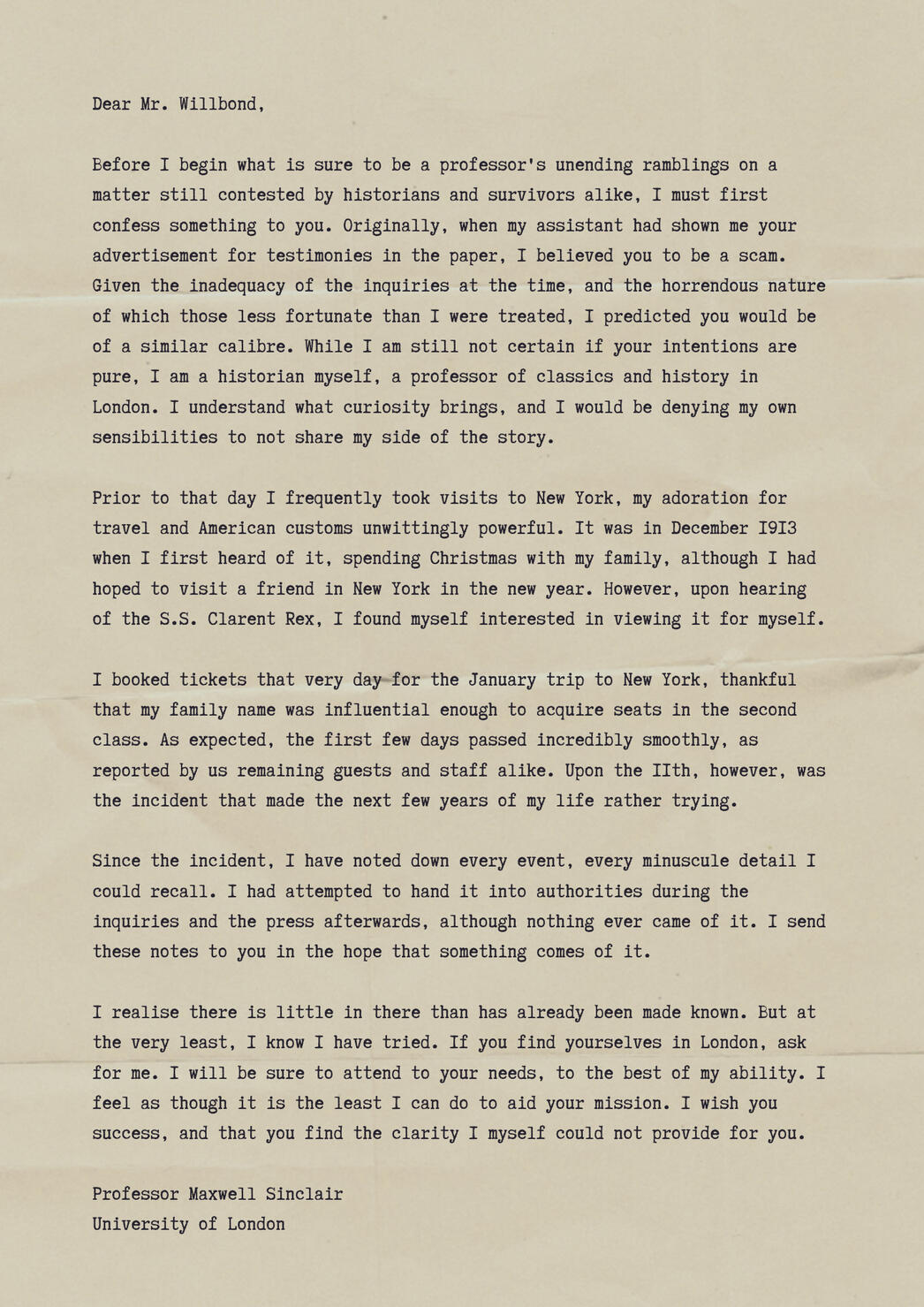
COMING SOON!
Stay tuned! Join our Discord community here to receive direct updates from the Seawright Historical Society!
Curiosity. It's a terrible thing. You would understand, right?Your friend,
Charles.
DONTLOOKBACK.Your friend,
Charles.
S.S. CLARENT SINKS, KILLING 2500 PASSENGERS. MANAGING DIRECTOR, ISIDORE SEAWRIGHT, PROVES HIMSELF TO BE A _ _ _ _ _ _ !
“Life is infinitely stranger than anything
which the mind of man could invent.”
-Arthur Conan Doyle
S.S. CLARENT SINKS, KILLING 2500 PASSENGERS. MANAGING DIRECTOR, ISIDORE SEAWRIGHT, PROVES HIMSELF TO BE A C _ _ _ _ _ !
“Life is infinitely stranger than anything
which the mind of man could invent.”
-Arthur Conan Doyle
S.S. CLARENT SINKS, KILLING 2500 PASSENGERS. MANAGING DIRECTOR, ISIDORE SEAWRIGHT, PROVES HIMSELF TO BE A CO_ _ _ _ !
“Life is infinitely stranger than anything
which the mind of man could invent.”
-Arthur Conan Doyle
S.S. CLARENT SINKS, KILLING 2500 PASSENGERS. MANAGING DIRECTOR, ISIDORE SEAWRIGHT, PROVES HIMSELF TO BE A COW _ _ _ !
“Life is infinitely stranger than anything
which the mind of man could invent.”
-Arthur Conan Doyle
S.S. CLARENT SINKS, KILLING 2500 PASSENGERS. MANAGING DIRECTOR, ISIDORE SEAWRIGHT, PROVES HIMSELF TO BE A COWA__!
“Life is infinitely stranger than anything
which the mind of man could invent.”
-Arthur Conan Doyle
S.S. CLARENT SINKS, KILLING 2500 PASSENGERS. MANAGING DIRECTOR, ISIDORE SEAWRIGHT, PROVES HIMSELF TO BE A COWAR_!
“Life is infinitely stranger than anything
which the mind of man could invent.”
-Arthur Conan Doyle
S.S. CLARENT SINKS, KILLING 2500 PASSENGERS. MANAGING DIRECTOR, ISIDORE SEAWRIGHT, PROVES HIMSELF TO BE A COWARD!
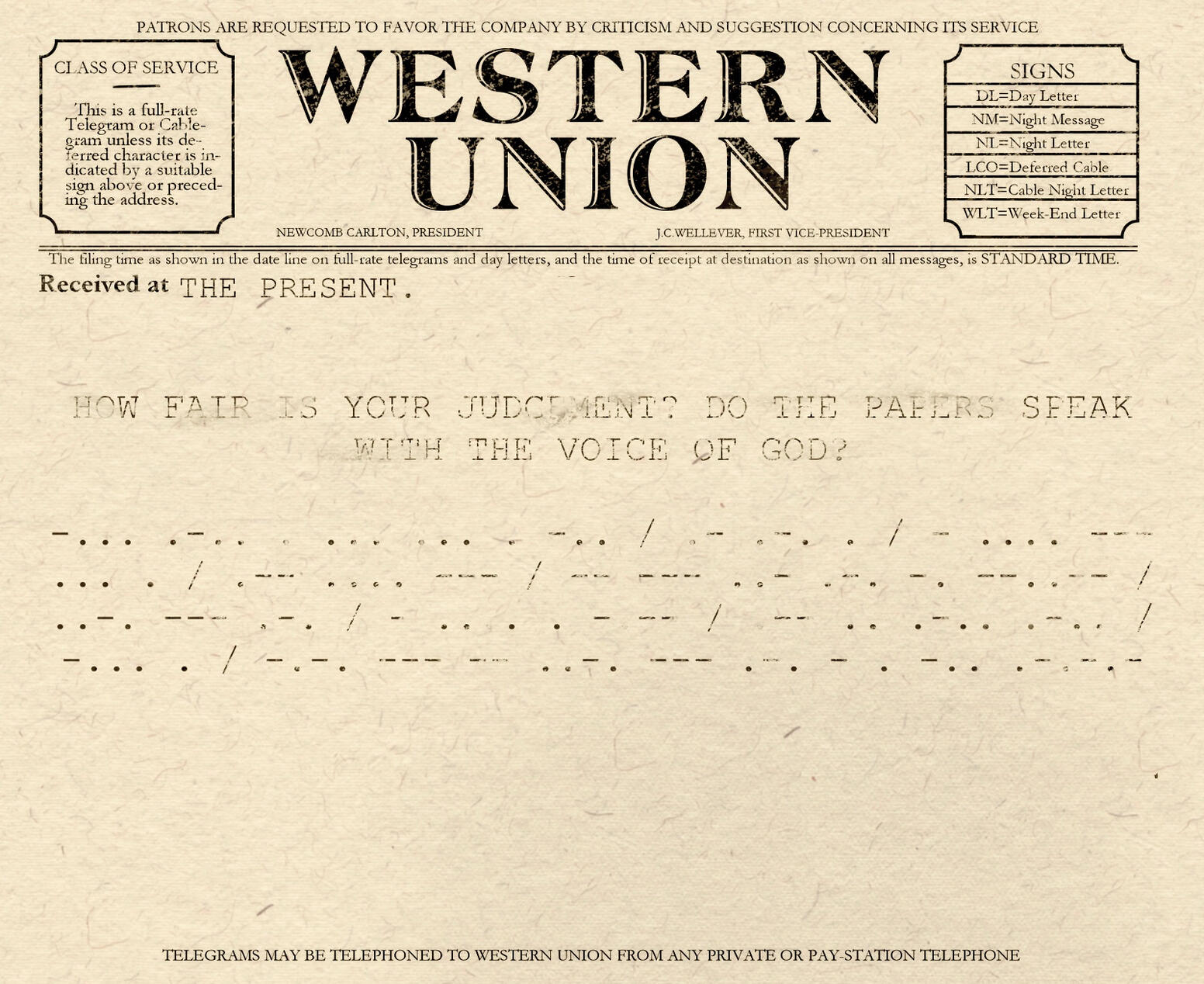
GENERAL REGISTER OFFICE
CERTIFIED COPY OF AN ENTRY OF DEATHREGISTRATION DISTRICT:N/A
NAME OF DECEASED: ISIDORE SOLOMON SEAWRIGHT
DATE OF DEATH: FOURTEENTH JANUARY 1917
PLACE OF DEATH: [REDACTED]
SEX: MALE
AGE: 53
OCCUPATION: COMPANY DIRECTOR
CAUSE OF DEATH: [ ]
Who decides history? It is not the men who make it but the men who remember it. The men who write the story and forge it into legend. From mercury to gold.Your friend,
Charles.
CONTENT WARNINGS AND CONTEXT
Hello again! We at the Seawright Historical Society hope that this letter finds you well. “Dear Clarent” aims to recall the legacy of the Seawright Line, the S.S. Clarent Rex, and those whose lives were so inherently intertwined with them. Those of us in the modern day have the privilege of living in a more informed world, therefore this deep-dive into the past will contain potentially uncomfortable content that reflects the time period it originates from. Before you begin your voyage, here is a list of triggers that appear throughout the story:-Mental Health & Suicide
-Familial Abuse
-Sexism
-Colonialism & Imperialism
-Depictions of Injuries and Gore
-HomophobiaWe wish for you to know that when dealing with these in creating our story, the team always puts great effort into researching the subject matter. We employ research through research papers, books, speaking directly to experts, and more. If any content in Dear Clarent is greatly inaccurate or insensitive, please feel free to contact us anytime at [email protected]. We value thoroughly informing ourselves of the complexities and nuances of our content via consistent education on a range of perspectives in both modern and historical settings. To ensure well-rounded quality when dealing with heavier subjects, the Seawright Historical Society works with various volunteer sensitivity readers before each release. We do not wish to glorify or romanticize the triggers listed above, but they do appear in Dear Clarent and its extended universe as an expression of a grim historical reality through the means of a fictional narrative.CREATOR’S ADDITION:Thank you for your support of Dear Clarent. I want to share here my personal perspective on this story and my intentions when writing it.
I wish to start by adding onto the end of the main letter. I would like to make it clear that while I put time and care into each character that I’ve created, I do not necessarily condone their actions or beliefs. I write historical fiction based on real events and real people; many were very far from what we can consider “good” or “ideal”. In fact, many of my characters were created from my own studies of real life industrialists and political figures. I like to tell stories with vintage settings and contexts, but by no means do I support “vintage values”. I simply consider myself fascinated when exploring the topic of personal versus societal morality, and wish to do so through revisiting a popular and familiar, but unsettling past. Being informed of how far we have progressed is incredibly important. My intentions are simply to create an original story and world that viewers can explore while also learning even a little about the actual problems of that time. Of course I admire the glittering gold aesthetics of the Gilded Age from an artistic POV but the fact is that the glamor of the “Gilded” Age is merely a facade for the exploitation and sorrows that would enable such luxury. Likewise, Dear Clarent borrows aspects of design and culture for that time but always solely in a fictional/narrative sense.
Again, please accept my sincerest thanks for your support of Dear Clarent and for understanding the intention and dedication that went into its creation. I hope that this tale entertains and informs as it's presented!
December 11, 1887
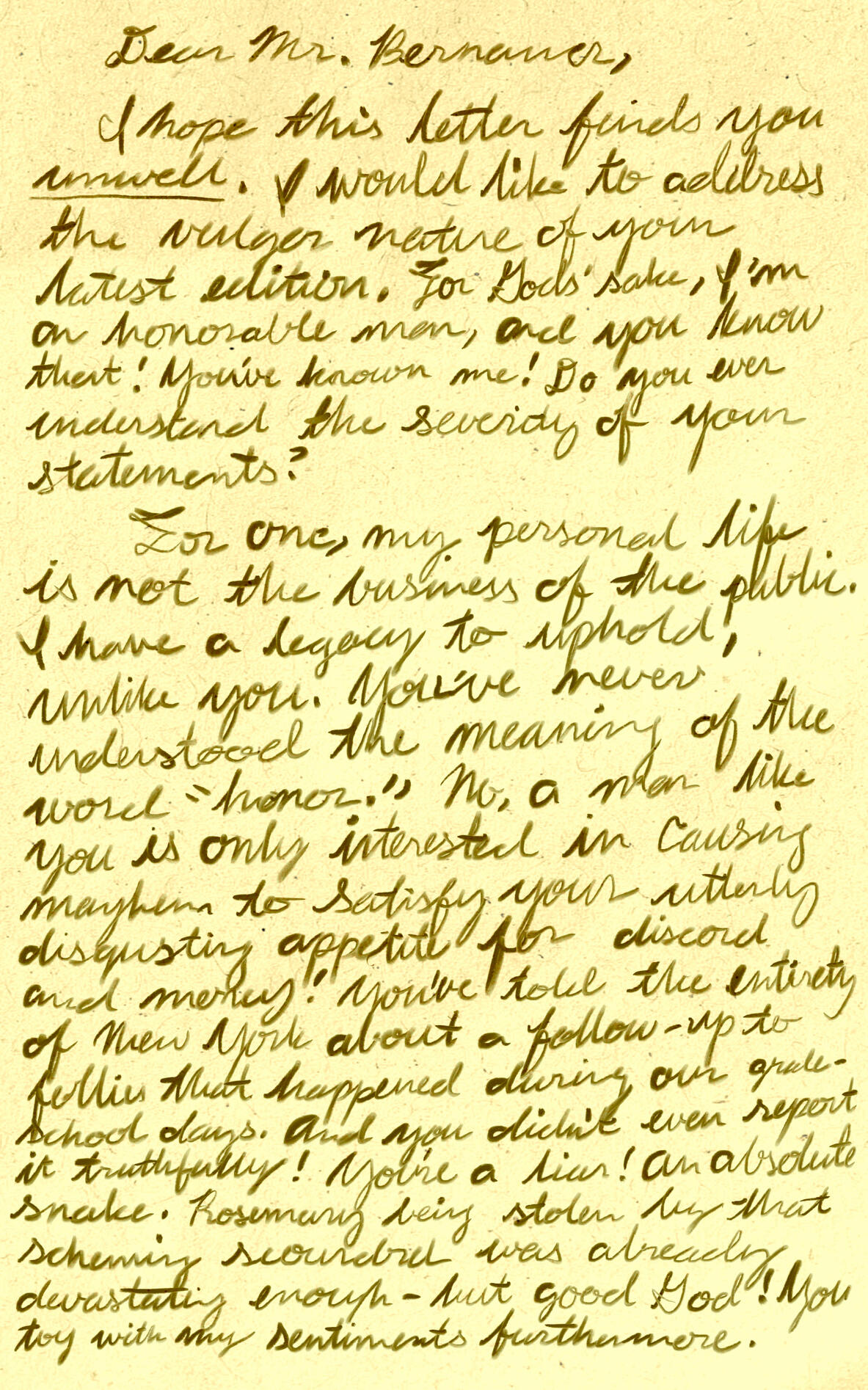
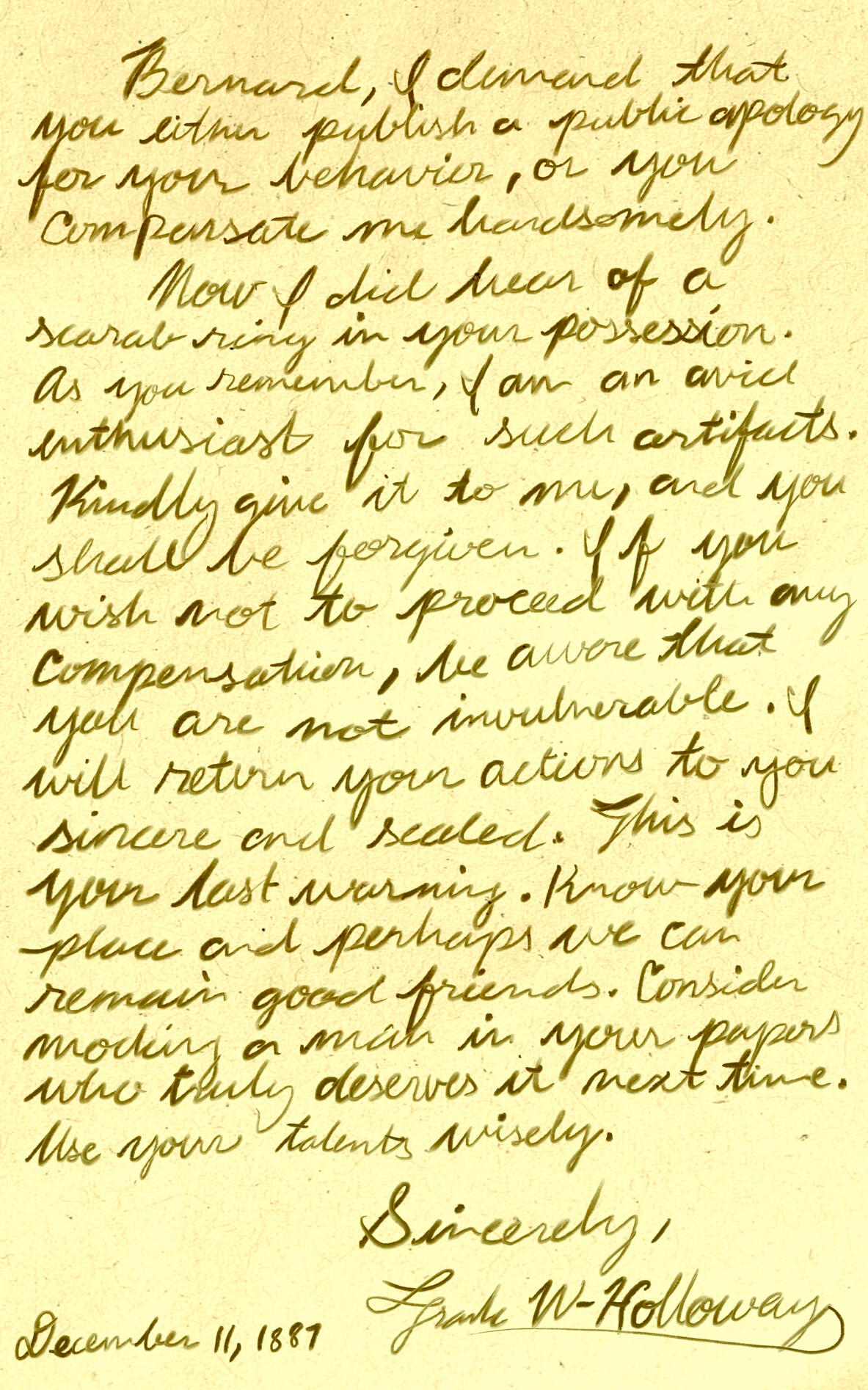
April 1, 1895
THE SEAWRIGHT LETTERS
View our archive of correspondence between members of the Seawright family and associates.
Isidore Seawright to Marvyn Seawright, 1905.
Isidore Seawright to Phoebe Goldfinch, 1885.
Noah Seawright to Isidore Seawright, 1885.
[UNSENT] Isidore Seawright to Noah Seawright, 1874
The following is a PARTIAL TRANSCRIPT of Noah Seawright's last will and testament. The original document has likely been destroyed. All of the following text was recovered from a (damaged) notebook belonging to the medical examiner of Regina-by-the-Sea in 1908.[ENTRY BEGINS]I, Noah Seawright of Regina-by-the-Sea, do hereby make my last will and testament in manner and for following that is to say. I request that my body may be interred in [MISSING EXCERPT][SECOND NOTE]To my wife Diana Forman-Seawright, I grant her the full usage of properties associated with the Seawright Estate. [MISSING EXCERPT][THIRD NOTE]To my son, Marvyn Seawright, I grant complete ownership and management of the entire Seawright Estate. This includes all associated properties, vehicles, heirlooms, and miscellaneous items, with the exclusion of the Seawright Line company. Furthermore, I intend to leave him eighty-percent of Seawright Estate funds as well as [MISSING EXCERPT][FOURTH NOTE]To my son, Isidore Seawright, I grant complete ownership and management of the Seawright Line company as well as twenty percent of Seawright Estate funds.[ADDITIONAL LETTER, FOUND IN 1917]
The following is a TRANSCRIPT of a letter previously attached to Noah Seawright's last will and testament, addressed to Isidore Seawright. The letter itself was found nine years later, folded and water-damaged in Isidore Seawright's waistcoat pocket.[LETTER BEGINS]
To my son, Isidore.You will be reading this letter upon the news of my death. I intend it to be attached to my will and testament, which I will assume that you have seen prior to reading this and are likely disappointed.As I am writing this, I am on my deathbed, in the house where myself, you, Marvyn, and now your children will have been raised. Let it be known that by residing in this household, you are a Seawright. I understand that often, I may not have been the best of fathers but recognize that I lived by the principles laid down by God. I carry no regrets in not sparing the rod, but I do have regrets in not spoiling you with the following knowledge sooner.There have been a number of times when I have not shared any sort of affection or time with you. There have been an even greater number of times when my anger has overtaken me. That is not how a man of God- a man of the Seawright name- should conduct himself. I now ask your forgiveness- but know that I had my reasons for my dissatisfaction. Even God in Heaven, which I pray to enter, has His righteous anger. Recognize that as the head of such a family, we must set an example, maintain an image for those who look up to us. I only ever wished for you to reflect the values that the Seawright name has stood for- and for your own wellbeing. I digress.I leave you only twenty-percent of our funds because while you are my son, you are not that of your "mother"- otherwise known as Diana Forman-Seawright, the woman who raised you. Your brother will inherit the majority as he is her son in our lawful marriage. Do not mistake her- she took it upon herself to tend to you to the extent of her abilities. Nonetheless, by just her faith alone she has reason to express some degree of distance from you. She is a good woman, and I wish that you still place effort in sustaining her wellbeing after my departure.As for your "true" mother.Her name was Marian Eldrige. We had met when I was much younger and foolish. During those years in which it is natural for a youthful man of the world to heed the call of adventure, I charted my course for America- New York, in hopes of witnessing the marvels of the New World that were whispered of in the papers of my day. I was inspired by Commodore Vanderbilt, who made his fortune first from ships and later from the railroad- a novel yet marvelous thing then. I hoped to chase the his same sort of glory for myself, but instead was swept away by the personal charms of New York City- the enchanting mansions, dining, and women. One lady in particular offered to be my guide as I ventured down each street, trying to make sense of American social customs. That lady of course, was your mother, who then was a student at the National Academy of Design. She dreamed to make a career in illustration- that of the political, crude, and even vulgar kind. I was taken aback, yet in the end drawn to her forward nature as the sea reaches towards the sand.I was in love. There was no doubt. This "New World" was even more brilliant with her in it, her eye for finding joy in each and every nook and cranny, each brick and stair. She was unchained, unpredictable at times, an escape from what I am sure you understand as the confines of our pedigree. Of course, my own father did not grant us his blessing when I asked for her hand in marriage despite the similarity in our social standing. Still, I did not respect his wishes and spent countless days with her in between my voyages. Upon each arrival to New York, she would gift me with another painting of hers- the very same paintings that have been hung on the walls of our parlour.Eventually, I received word in around July of 1863 that she had conceived a child by my doing- you. Shaken by the mere idea of fatherhood, still under the firm grasp of my own father, I was determined to marry her so that we may receive full privileges from my father, the Church, and the government. I intended to be fully present in your life. I had considered abandoning a life at sea, but it was too late. My brother, your late uncle, was given command of the Seawright Line. Even then, my father would still refuse to bless our union- he had instead arranged a marriage for me. At the time, Diana Forman was but a shy, unattached girl that I had never even heard of. He wanted to wed us to form an alliance with a foreign businessman, I believe. Still, my heart was reserved for Marian Eldrige.At the time of the announcement of the arrangement, I was staying in New York with your mother, attending to her needs in the months prior to your birth. I refused to return until my father sent me a letter the week following your birth detailing his plans to revoke what remained of my inheritance if I did not return at once. Afraid, I planned to bring Marian with me, somehow steal the allotted inheritance, and create a new life with her, myself, and you.I immediately learned that the hand of God is cruel, but just.For the voyage back to Regina-by-the-Sea, you, your mother, and I were traveling on the S.S. Lord Isaac. I believe the Washerwoman MacKenna told you a part of this. The vessel was set ablaze on the night before our scheduled arrival in Regina. Your mother went out onto the promenade deck to alleviate her seasickness at the time of the attack. By the time I reached where I believe she would have been, I had lost her in the mad crowds. I let her slip out of my sight for one moment and she was taken from me, forever.With great haste, I could only go back to retrieve you and ensure your safety. I was not a hero that night. I did not save any women, nor children besides yourself. I was a shameful thing, a scared fool. I failed the only thing a selfish man could learn to love. I simply fled the scene in the same lifeboat that I placed you in. All the while, countless innocents perished, your mother among them. I knew many of those passengers for as long as I could remember. And yet, because I was not the Captain that night, I became the coward.You were, and are, the last remaining part of Marian.Therefore I love you as much as I still love her, but because you bear her likeness, your very existence has brought me much pain. I have grown to deny and feel contempt at all that reminds me of her. You may have been an irresponsible and defiant ratbag a multitude more times than reasonable but this is the once instance for which you did not deserve scorn for. I wish for you to forgive me. From the day I lost her I have lived according to what the Bible, what my God has laid out for me from front to back in hopes that I may redeem myself enough to be with her again. You bear her innocence, and it frightens me. But just as I have grown from my follies with age, I pray that you do as well. I grapple with a sort of fear in the possibility that you and Mrs. Phoebe Seawright will learn the same lesson that I have.Your love will be temporary, but the Seawright reputation, the honor, must be upheld forever.I leave you now not only with twenty-percent of funds, but with these memories that have not been disclosed elsewhere. This is the guilt I confess to, and apologize for. Please show Morgan more kindness than I have.Above all, remember that sacrifice is the choice of absolute honor.Your father,
Noah
THE SEAWRIGHT LINE SONGBOOK
Daugerreologue
Evertheless
A Delightful Reverie
Rückkehrunruhe
Proposal
Harmonoia
Occhiolism
Eagre
Birth and Beloiter
Enoument






CARGO MANIFEST [INCOMPLETE]
| COMPANY | ITEM | DESCRIPTION (IF APPLICABLE) |
|---|---|---|
| Rickard's Emporium | 5 Case Clothing | Item No. 10737 |
| Dean and Decker Tea Co. | 20 Case Tea | Item No. 121262, "Webrich Wedding" |
| M. Davenport | 4 Case Wine, 2 Case Books | N/A |


TELEPHONE

The telephone as we know it was invented in 1861 by Philipp Reiss, although it was first patented by Alexander Graham Bell in 1876. The telephone in our collection belonged to newspaper mogul Bernard Bernauer. Bernauer was fascinated with audio as a new medium for news, and thus experimented often with radio and recording his own calls.
F.W-H. and B. Bernauer, April 1914
F.W-H. and B. Bernauer, April 1934
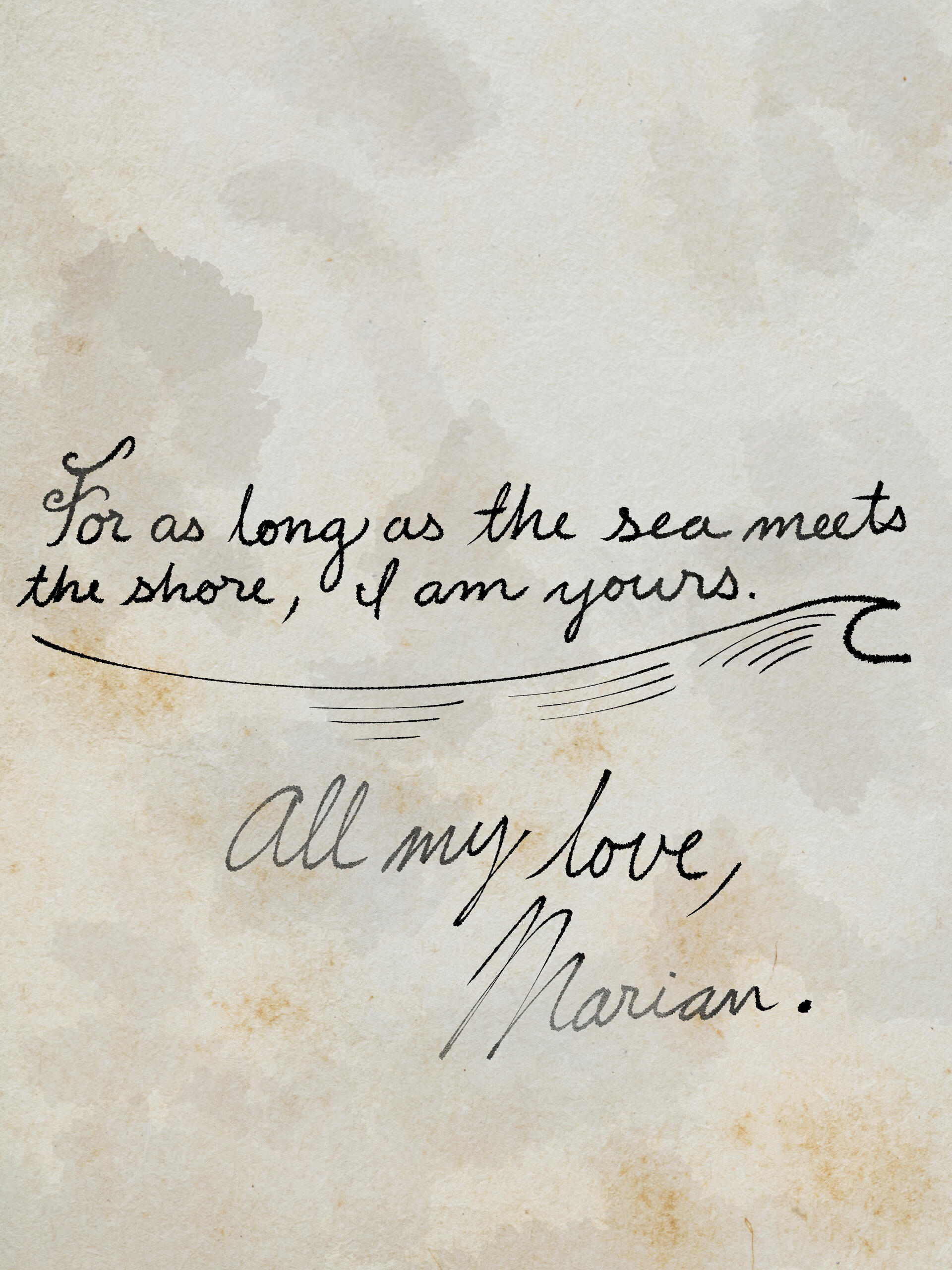

There's a memory inside.
My dearest Phoebe,
Why leave so early?
Your voice leaves me feeling
My heart is yearning!And our secrets lie
beneath the tidesDear, let’s go sailing tonight---My dearest Phoebe,
Leaving so early.
No fire forgiving
Star-crossed souls burning!all secrets die
Beneath the tidesDear, we’ll be sailing tonight
SURVIVOR REPORTS
Various survivors have appeared on
radio and television in the decades following
the S.S. Clarent Rex disaster. Listen to their
first-hand eyewitness reports here.

JOURNALS
Read recovered journal entries
from important figures
in the S.S. Clarent Rex tragedy here.
The rabbit picks a gardenia.
The scarab bites back.
The canary boasts a new song.
The scarab devours his spoils.
-.-. .-.. .- .-. . -. - / ... .. -. -.- .. -. --. .-.-.- / --. -. / --- -- .-.-.- / -- ..- -.-. .... / .-.. --- ...- . / - --- / .--. .. .--. . .-. .-.-.- / .... . / .. ... / ... .- ..-. . .-.-.- / .-- . / .-- . .-. . / .--. .- .-- -. ... / - --- / - .... .- - / - --- ..-. ..-. .-.-.- / --. -. / --- -- .-.-.- / --. --- --- -.. -... -.-- . .-.-.- / ..-. --- -..- .-- --- .-. - ....
December 25, 1944
[Anonymous Author]
----
There I found him, seated in silence.
I initially assumed that he was lost in prayer, his head bowed down in reverence.The snow fell upon him like dust,
for he was a man of the past.
An antique of dreaming days.
"The Gilded Age", as historians remember it.Yet, the only thing of gold in that blue night was the statue he faced:
Phineas Webrich.Some meager street-lamps lit the figure, his arms perpetually outstretched to the city he built.Perhaps the statue smiled brighter that night, as the beginning had become one with the end.For when I approached the man I found, he breathed no more.Slumped before that gilded pedestal, where he'd always placed Phineas.Long ago he clipped the dove’s wings, and at last- the rabbit lost the hunt, the bear understood the plight of the deer, and the canary fled the noxious colliery- but what then? He retreated into his garden, blooming with a million hues, yet not a soul to share that pleasure with. To pick a flower is murder, its death merely serving as selfish decoration for he who wears it. Yet, to let it live, is to be left with no adornations for oneself, and a sense of wonder for what could have been if one simply stuck their hands in the dirt.The shallow pursuit of beauty left him drowning with the rest—not in the sea, but in the ugliness of his soul and the depth of his regrets.2524 flowers, 2424 souls.“Best regards,Franklin”
Letters found between Felix Webrich and Morgan Seawright, 1920 - 1922

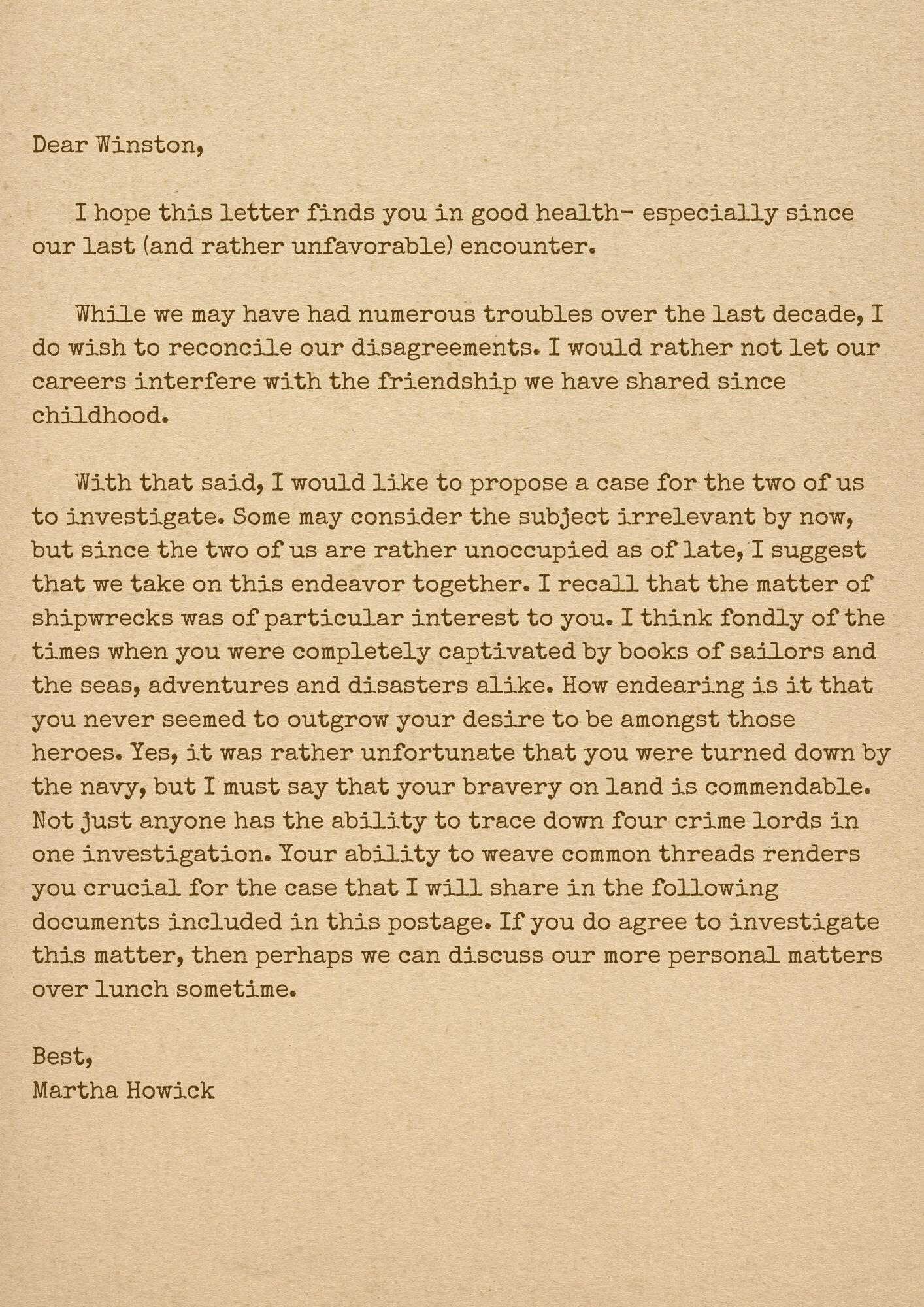
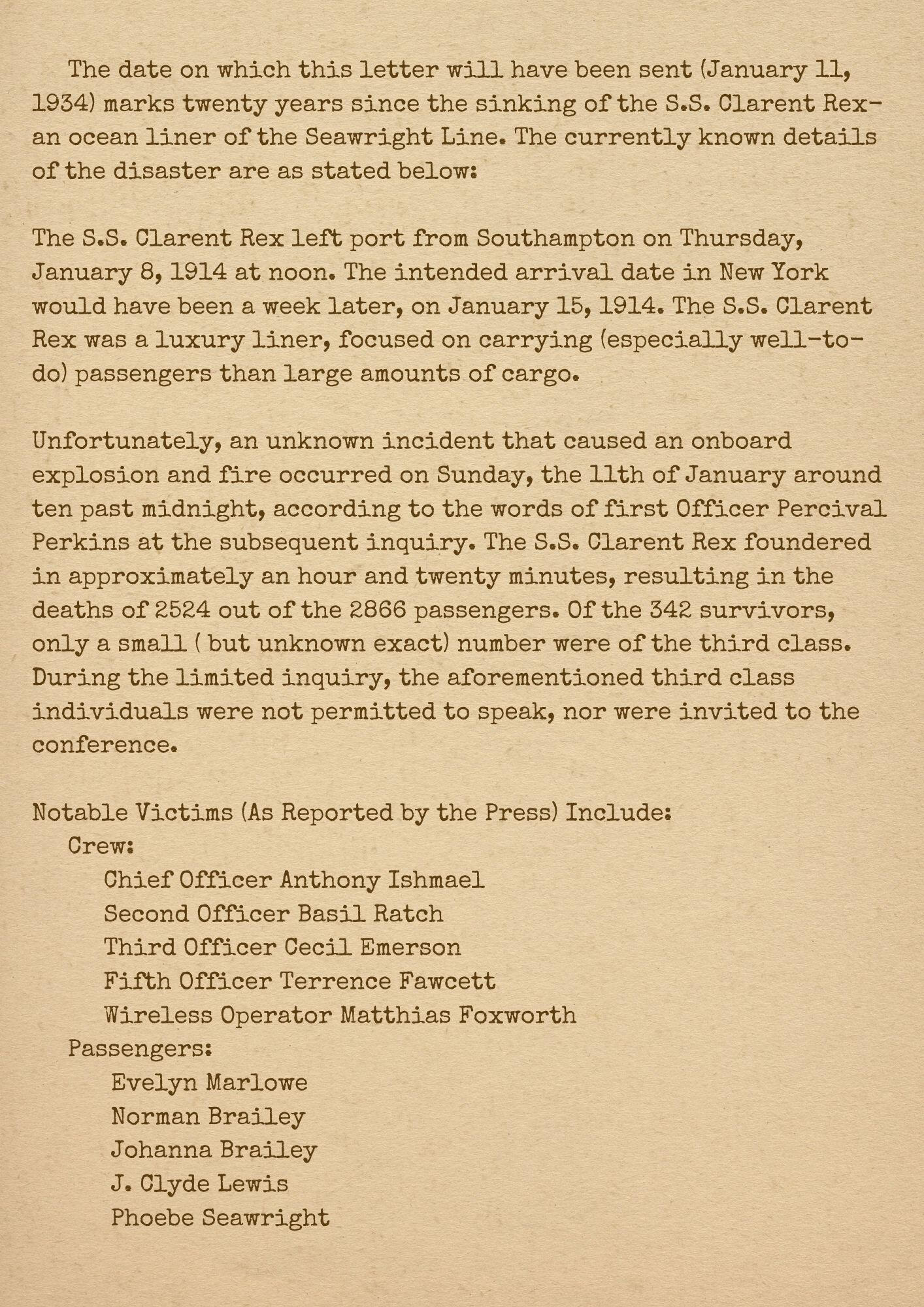
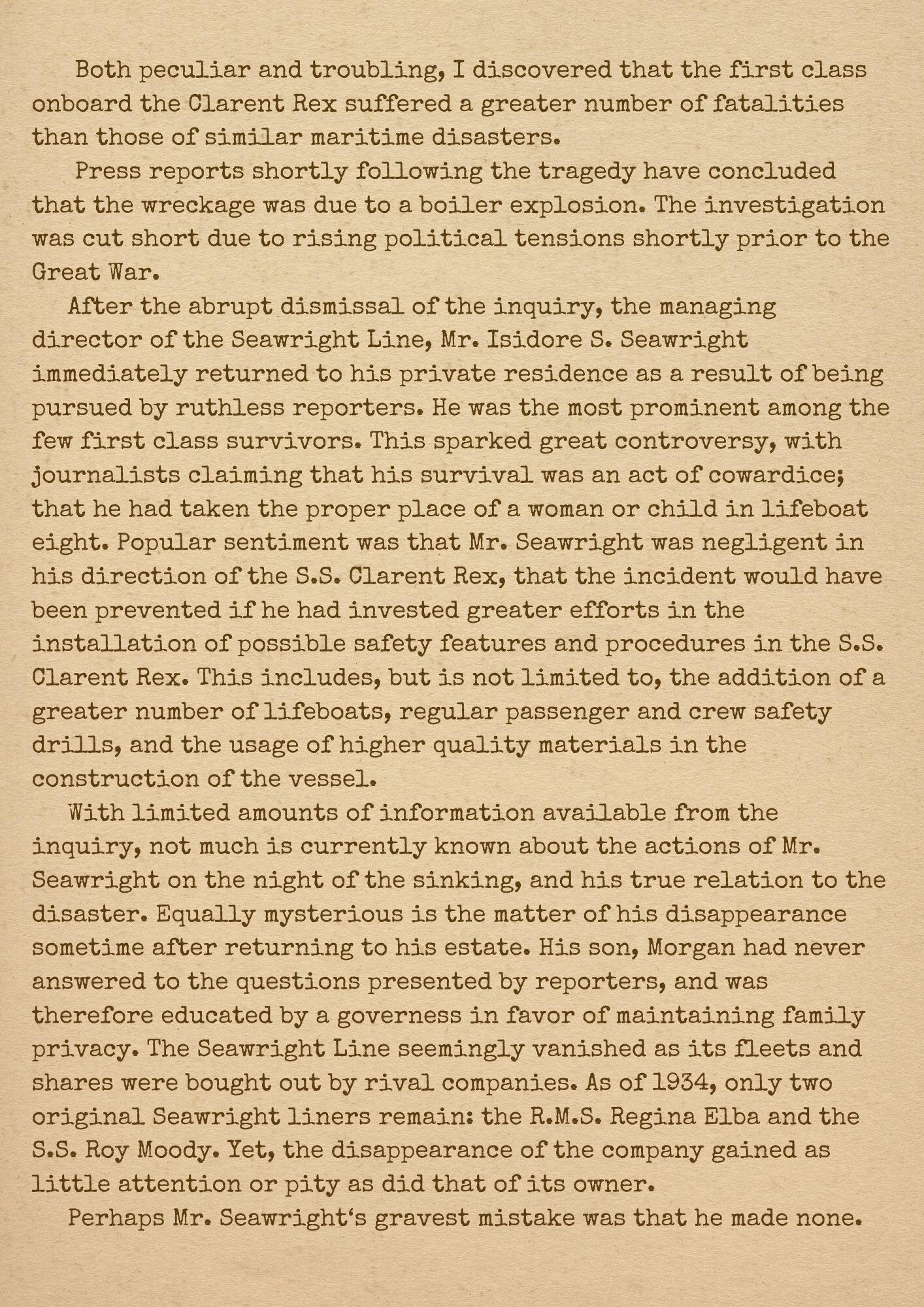
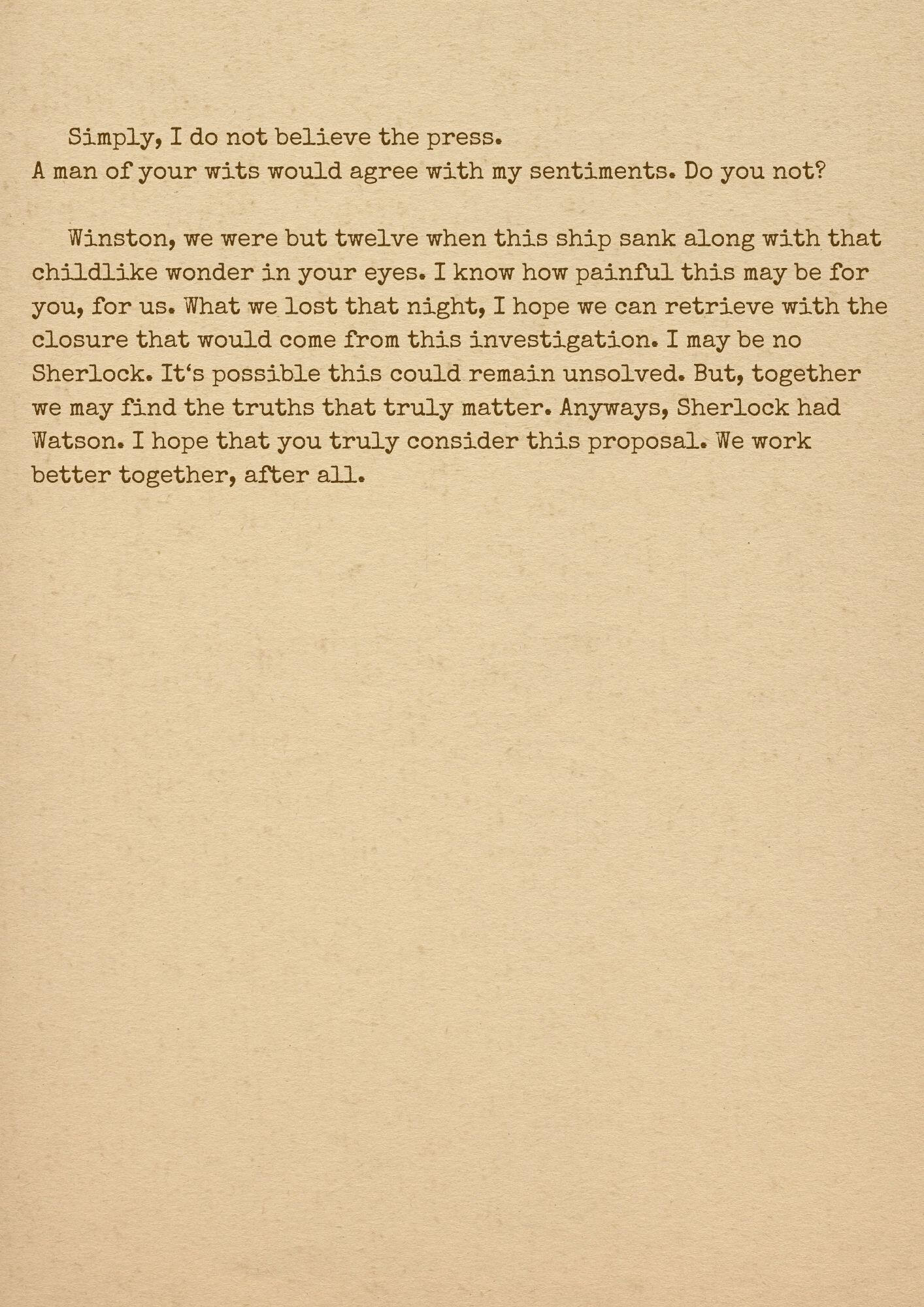


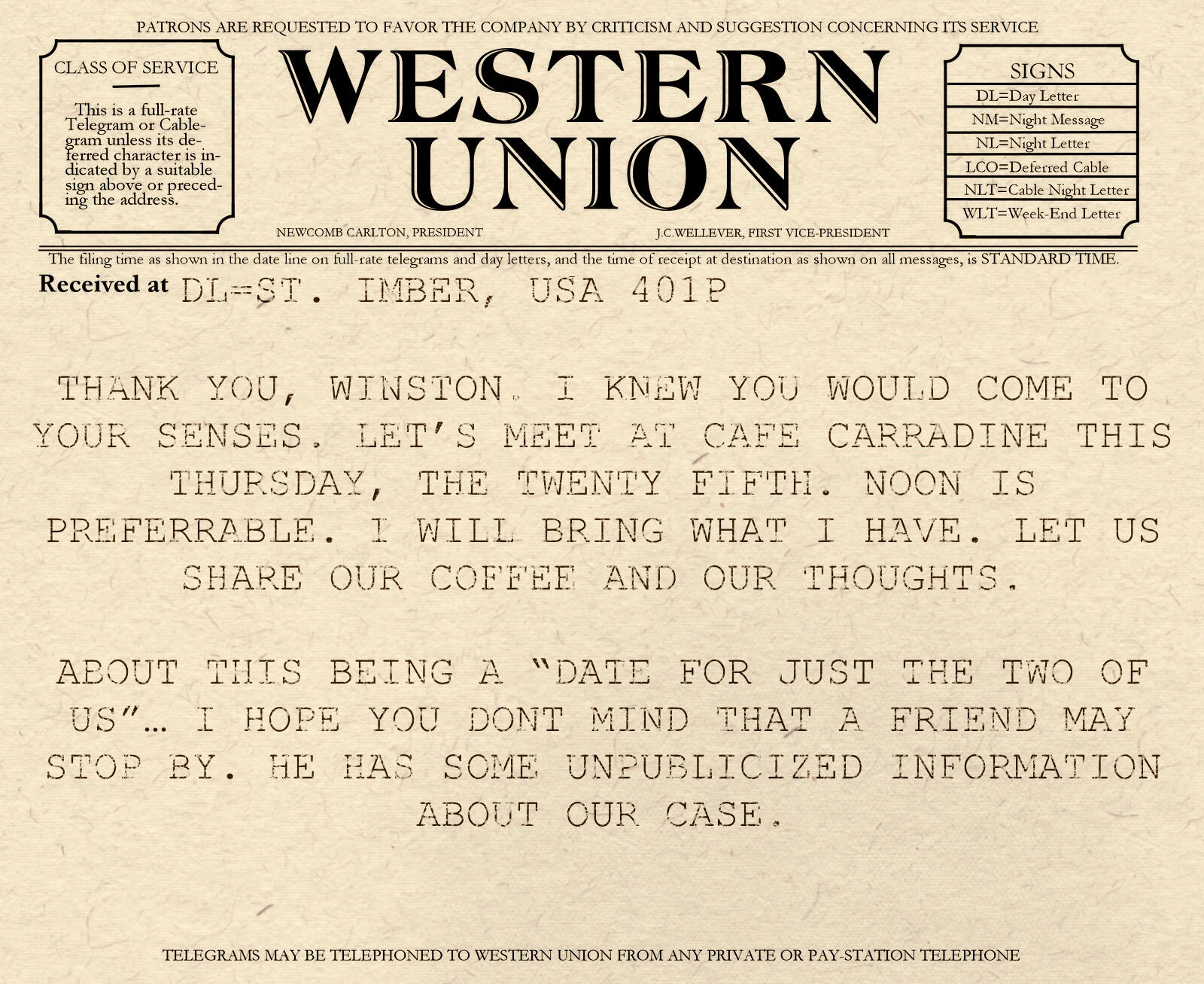

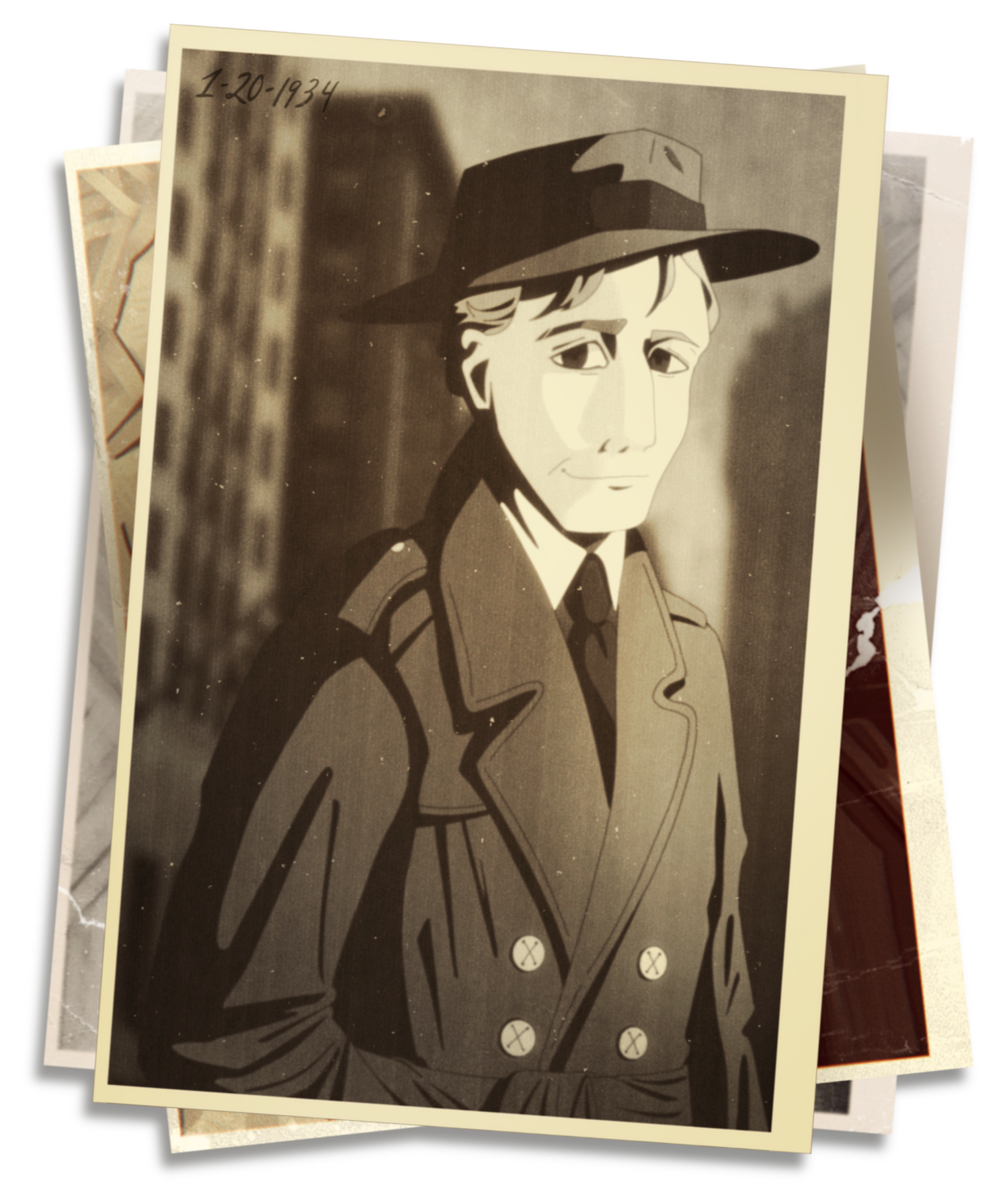










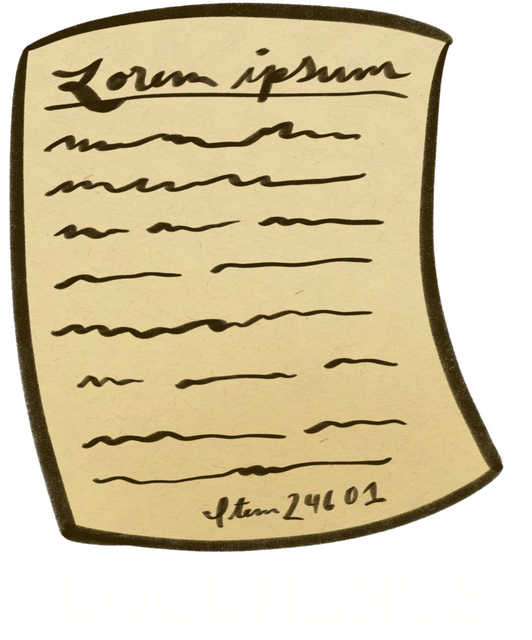



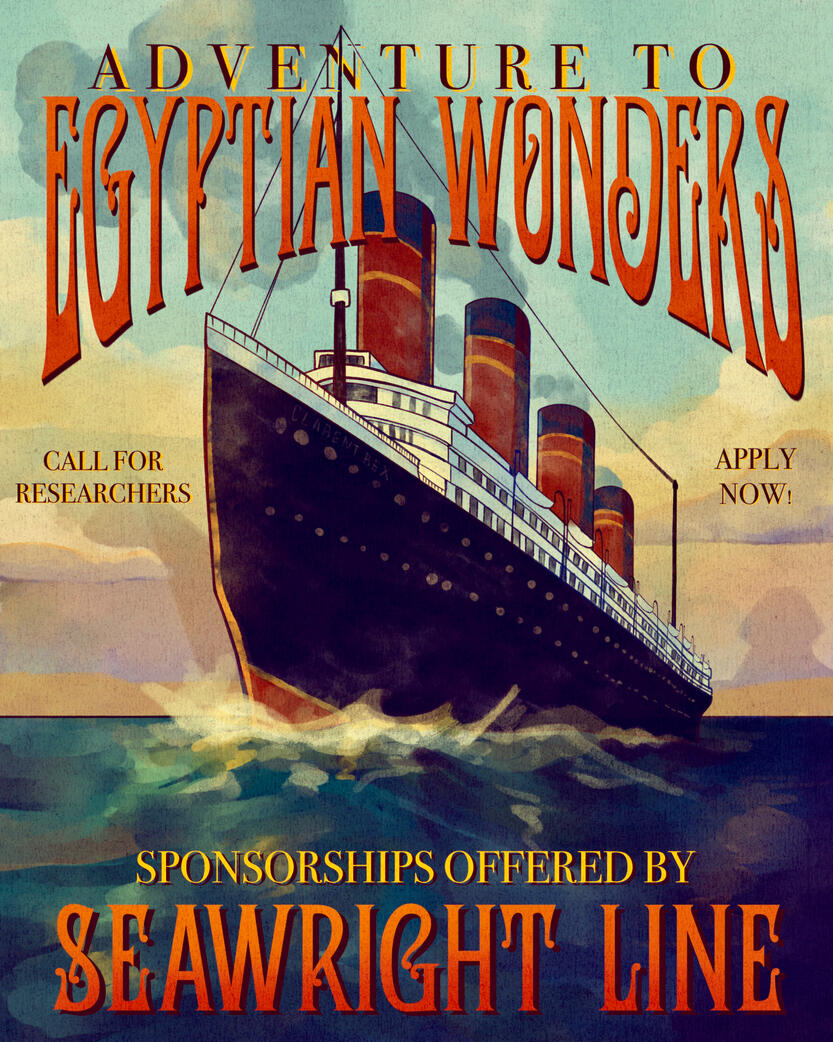
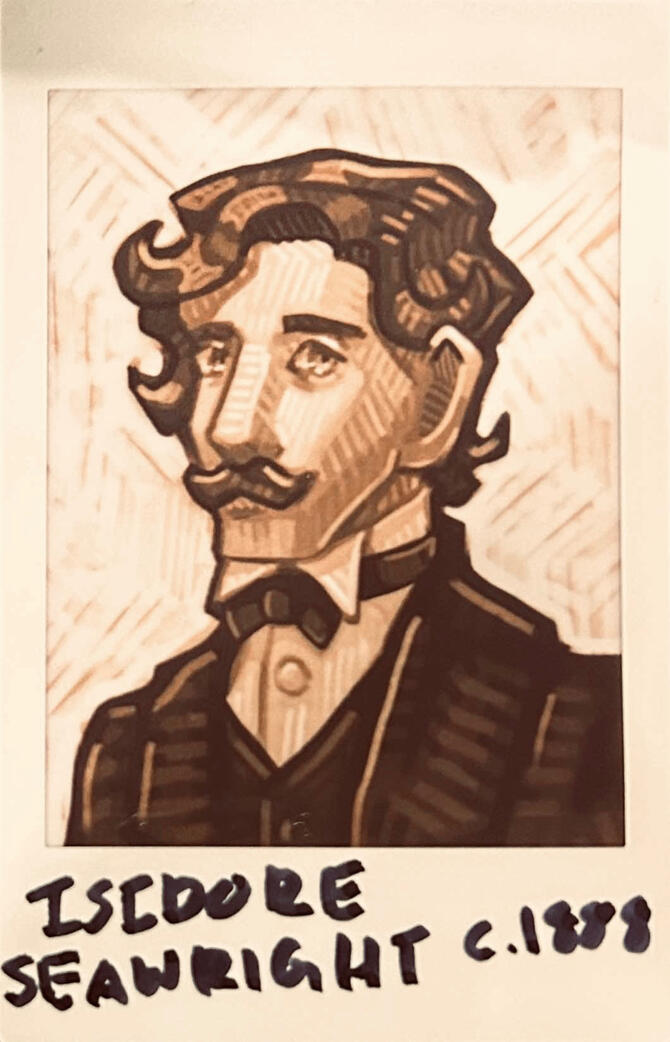

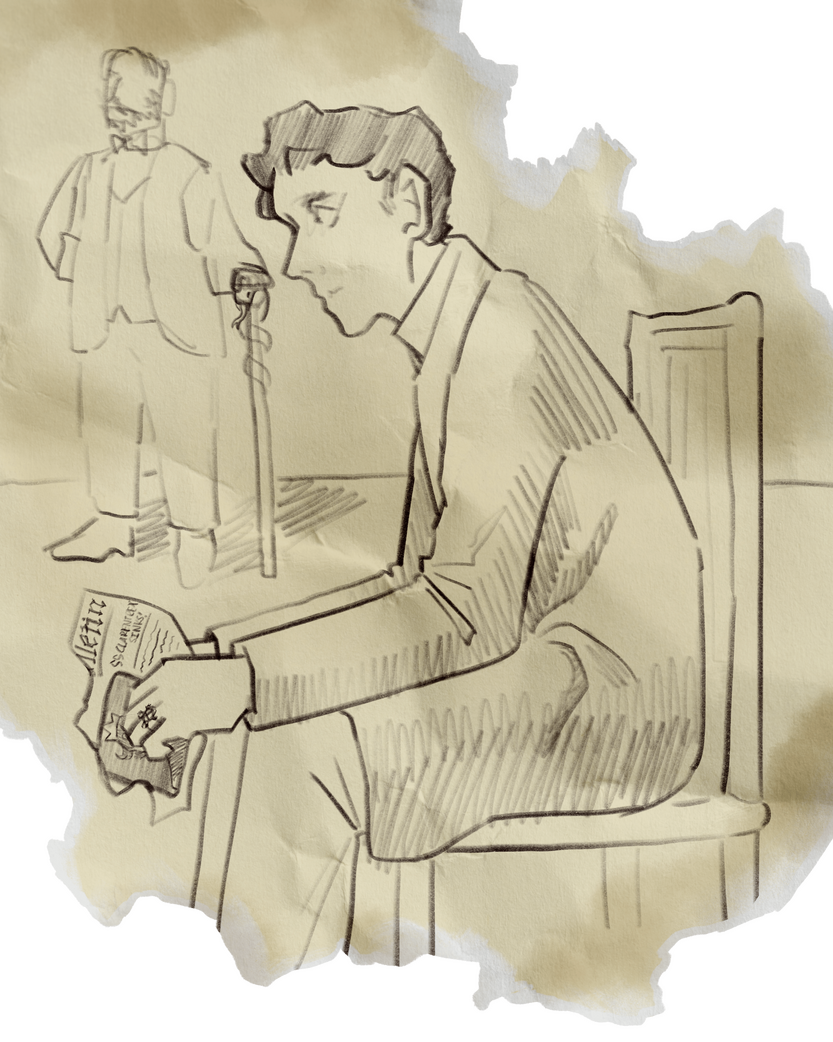
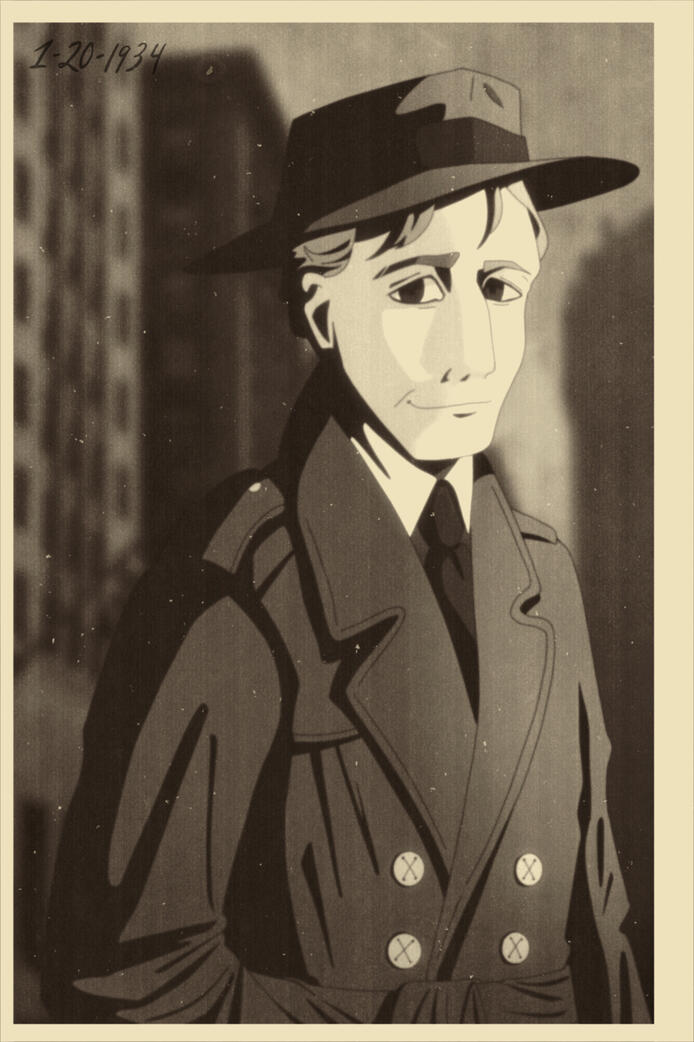
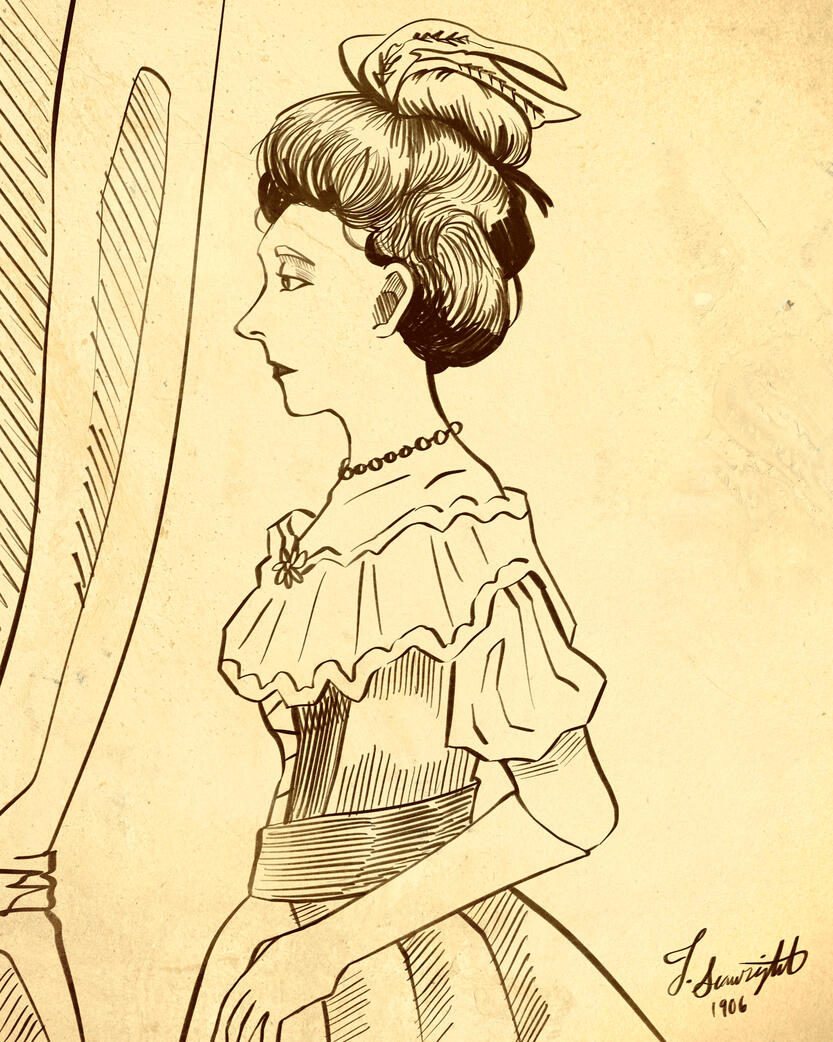
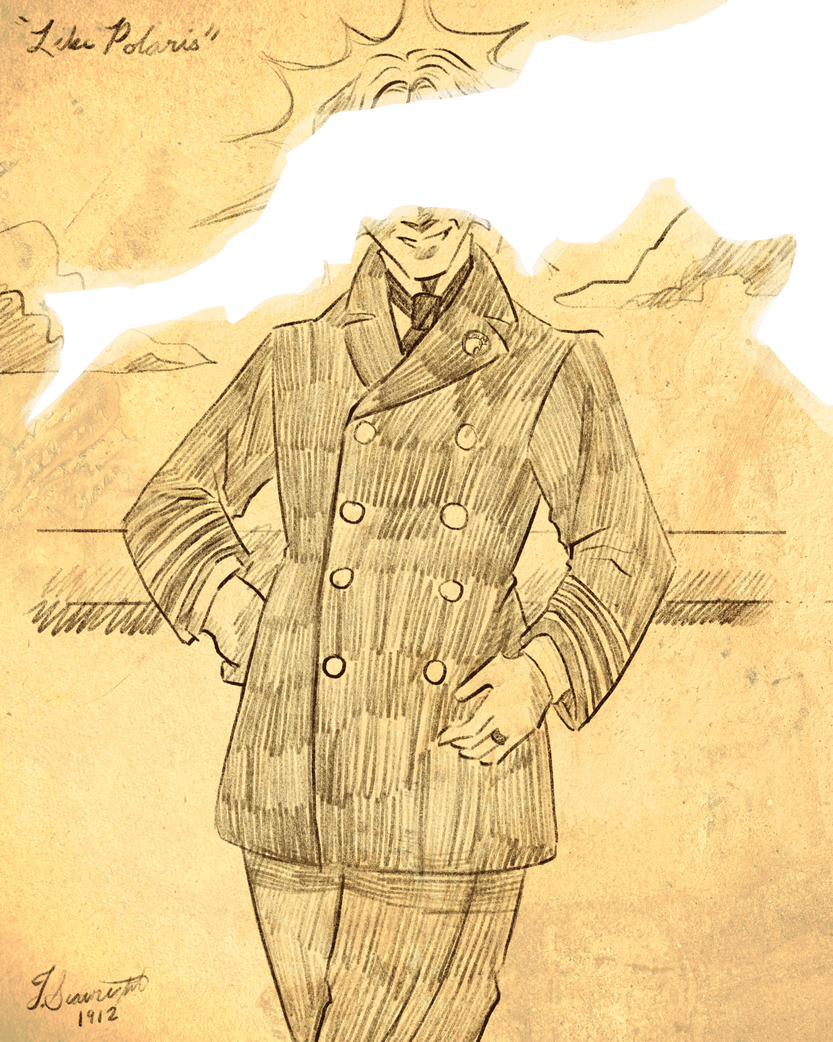



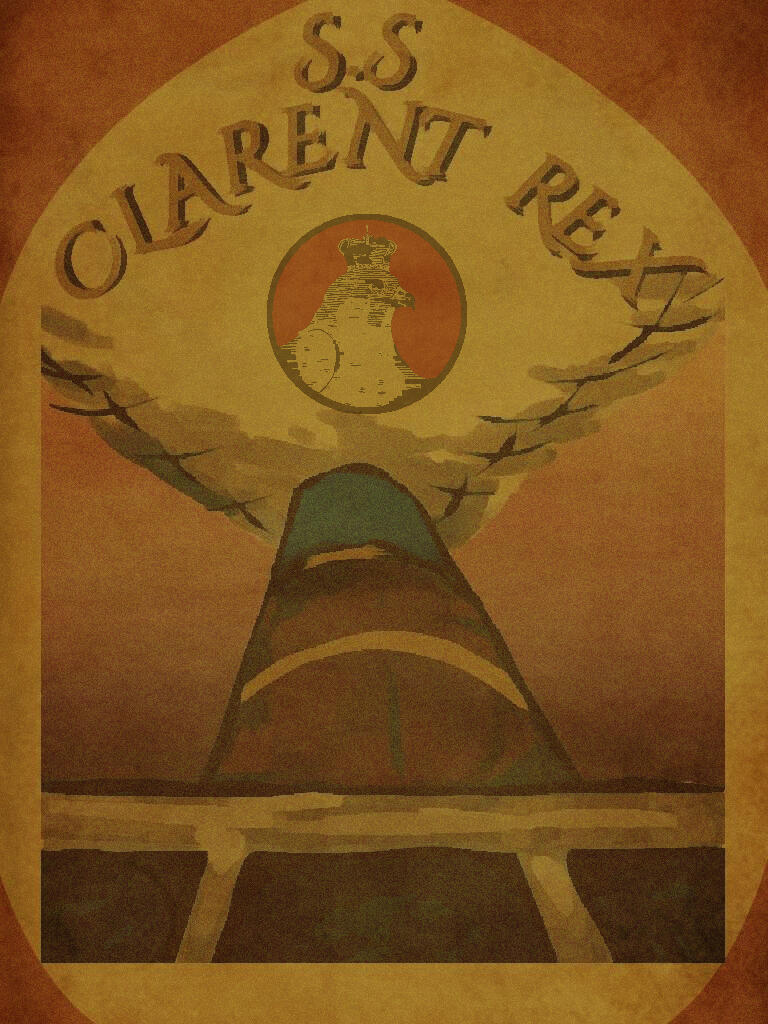








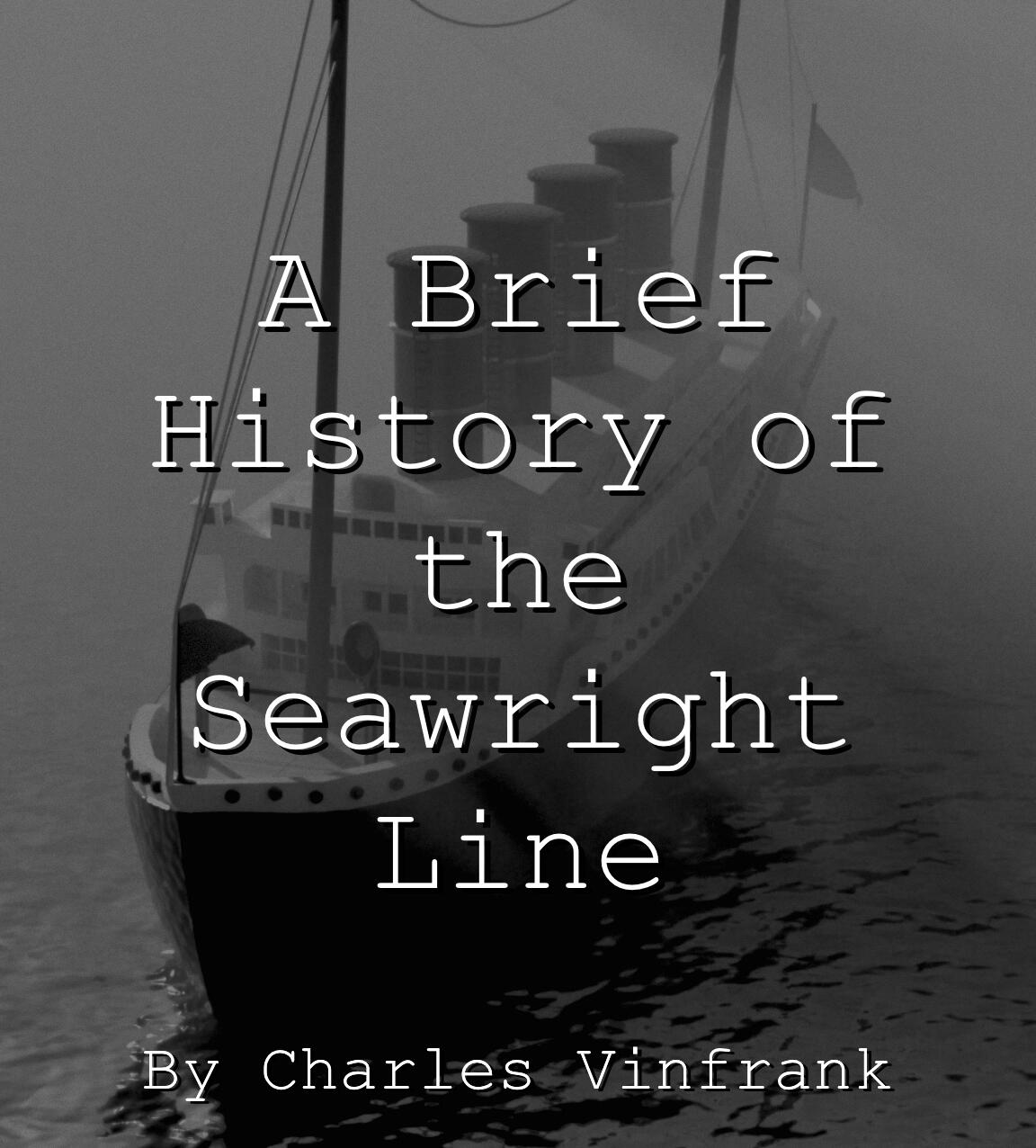


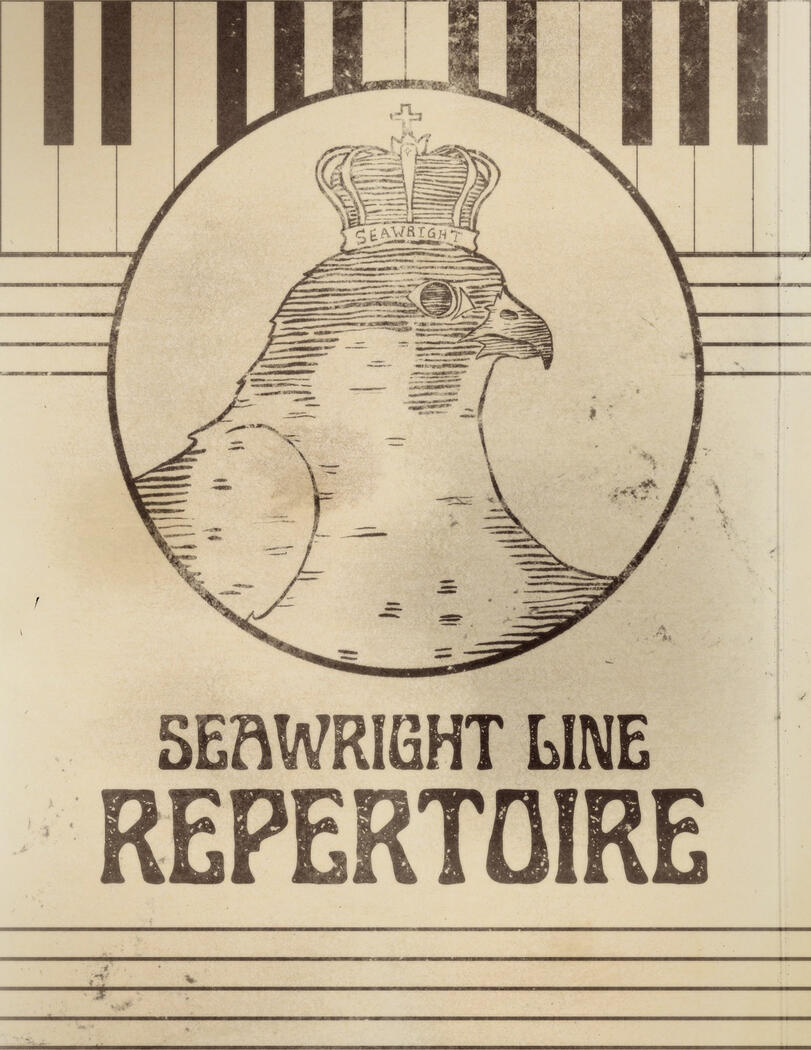



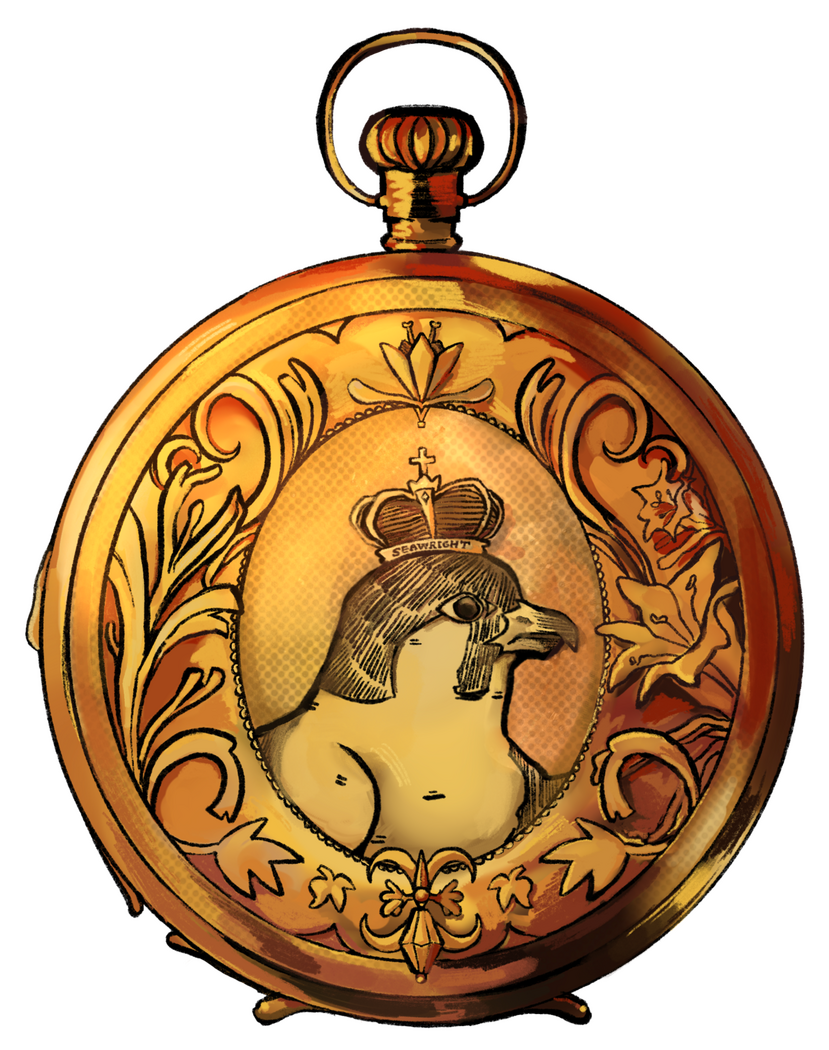



![Sealed envelope obtained from [REDACTED] family collection.](assets/images/gallery03/0ae35bc2.png?v=0e2eb77b)
